An Incredible Oregon Coast Road Trip (for First Timers)
The Oregon Coast is one of the most gorgeous parts of the Pacific Northwest, and that’s saying something considering the Northwest is full of incredible natural beauty.
Huge groves of towering sitka spruce trees, a coastline of beaches that oscillate between wide and sandy and rocky and full of sea stacks, and plenty of great food and hiking along the way.
Basically, a trip down the Oregon Coast has everything we love on a road trip.
We’ve done this drive many times now (Matt’s family lives in Seattle, Alysha’s lives in California, and we drive the coast to avoid the snow in the Siskiyous), and seem to discover something new on each foray down the wild stretch of coast that calls Oregon home.
And we’re here to do our best to help you plan a memorable trip down this stretch of coast that we know well and love.
Despite being sandwiched between our two home states of Washington and California, Oregon was a place that largely remained a mystery to us outside of Portland, which has been in the pantheon of our favorite cities in the world for many years now.
That is, until we had to reevaluate our travel plans (really, our entire life plans), when we had concocted an entire year of international travel that we got six weeks into before having to cancel everything.
The Oregon Coast was our first destination on our on-and-off two year US road trip a few years back, and we ended up spending a leisurely two weeks in the early summer camping our way up the Oregon Coast from the southern tip to the northern edge.
In addition to having driven the entire stretch of coast many times, we also live in Portland, so we often head out to the coast for a few days to escape the city and seek that fresh coastal breeze.
In this (very long) guide, we’re going to do our best to give you everything – and we do mean everything – we think you’ll need to plan your Oregon Coast road trip.
From the best stops to make and what to do and see at each stop, to where to stay and how to put it all together, we’ve compiled everything we know in this guide.
Sound good to you? Let’s get into it!
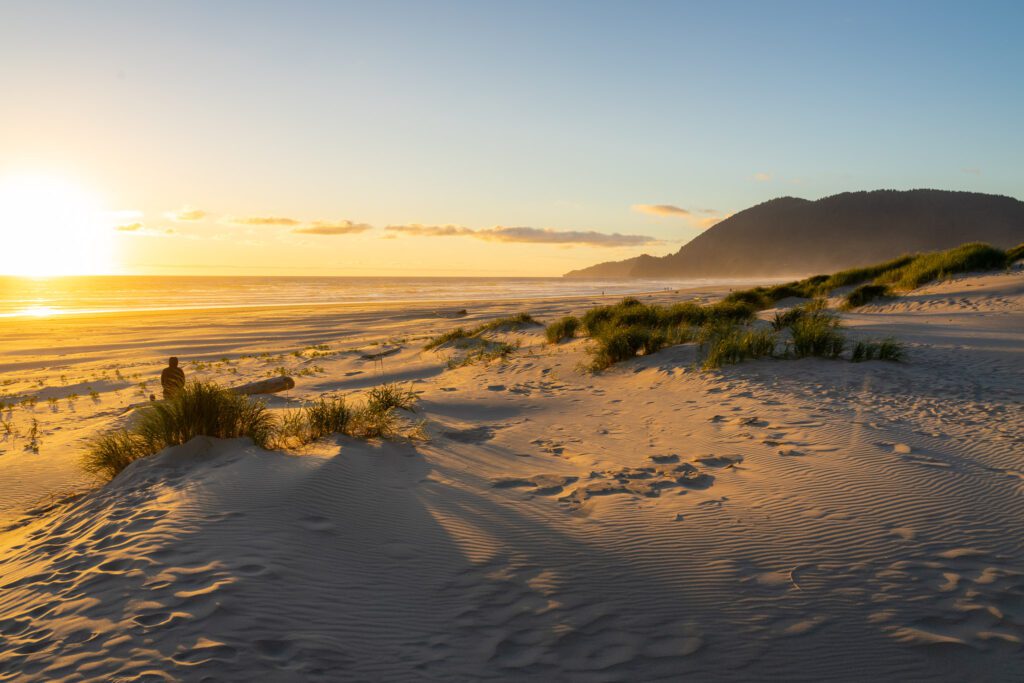
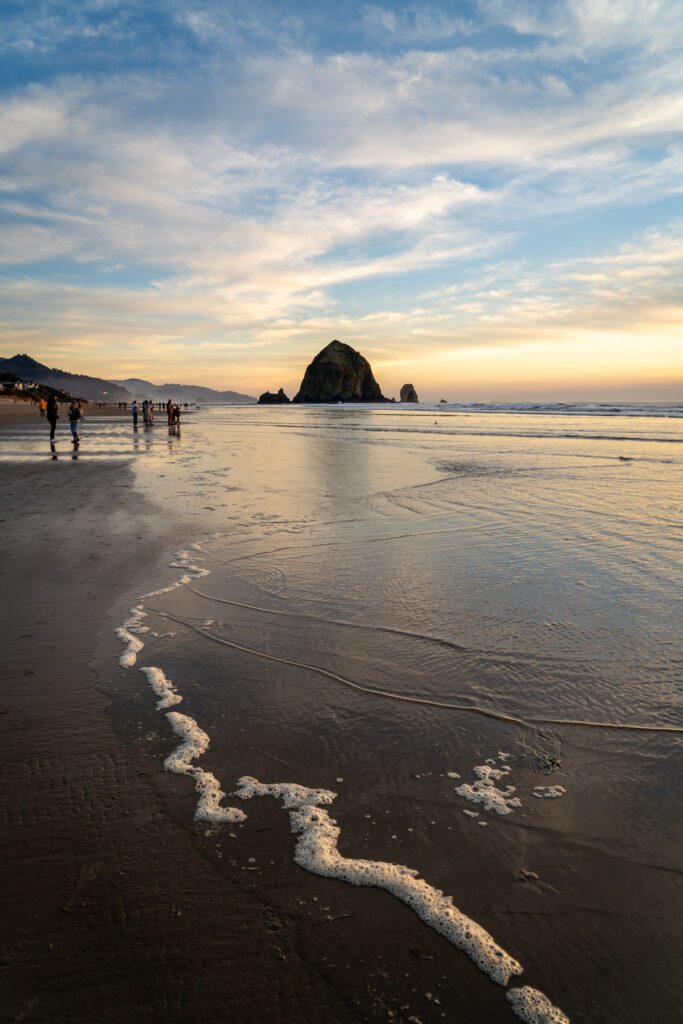
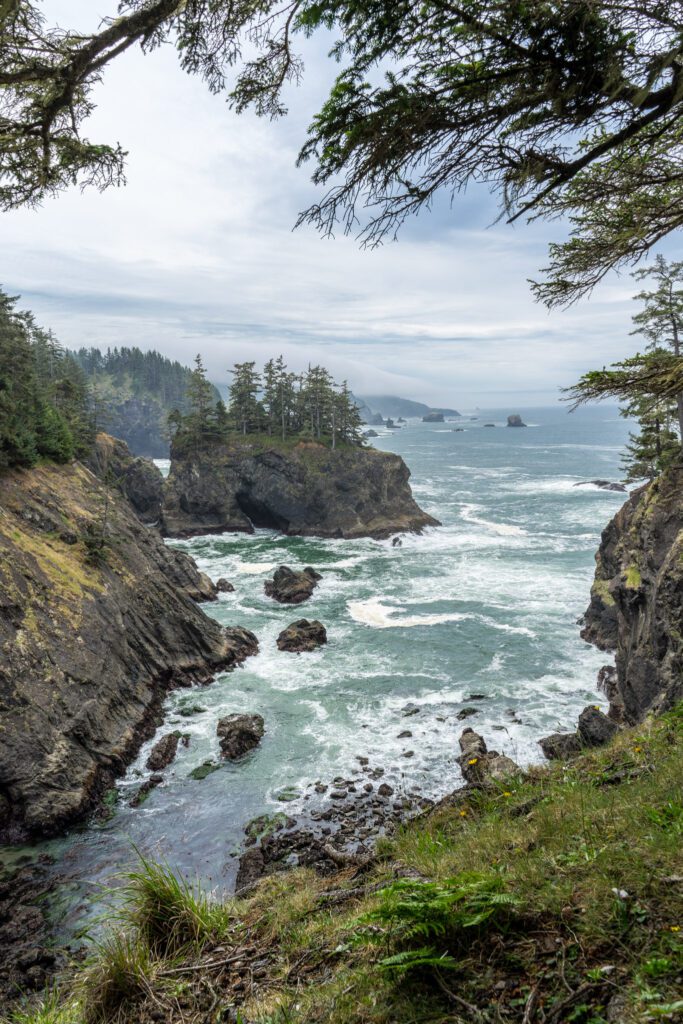
Disclaimer: Some of the links in this post, like hotel links, are affiliate links, meaning at no additional cost to you, we make a little bit of money if you click through and book. That being said, we would never recommend something to you that we don’t stand behind 100%.
How Many Days Do You Need on the Oregon Coast?
The short answer to this question is that, in order to do the Oregon Coast justice, we think you need at least ten days to drive it from end to end.
For reference, we spent a full two weeks on the Oregon Coast on our first ever trip AND have driven down the coast 3-4 times since (like we said, we’re in Portland and Alysha’s mom is in northern California, so we drive this fairly often), and there are still places we haven’t quite made it to yet.
In full, the drive from Astoria to Brookings – the points on the coast that are furthest north and south, respectively – is 340 miles, and will take you a hair under eight hours if you were to drive it straight through with no stops (which, of course, is not at all what you’ll be doing).
That being said, we also think you can see a good chunk of the coast within about 5-7 days, but we think it’s a bit too much to fit into that shorter timeframe (and we strongly recommend focusing on the northern half of the coast from Astoria to Newport).
You could easily spend 14 or 21 days out on the coast if you have the gift of time, but we landed on 10 days here as a good balance between being efficient and having enough time to see the highlights and fit in one or two spots that most people skip.
While we’ve written this itinerary for 10 days, we also have ideas for shorter and longer trips below the main itinerary, which you can use to help plan your specific trip.
Where to Start and End Your Road Trip
The answer to this question depends on where you’re coming from, but for most people the answer is Portland, Oregon.
Portland is by far the easiest city to fly into in Oregon – Portland International Airport (PDX) is also known for being one of the most pleasant airports in the country – has the best rental car options and prices, and is a lovely place to spend some time on either end of your road trip.
Now, Portland isn’t actually on the Oregon Coast – it’s about two hours away.
Which brings us around to the other question here – where do you fly out of, assuming you start in Portland and drive south down the coast?
Unfortunately, by the time you’re down in Brookings, you’re a full six and a half hours away from Portland (on a good day with no traffic), and you’re almost the same distance from San Francisco (which is about seven and a half hours south).
We have two options for you.
The first option is to simply add a day or two and drive back to Portland along I-5, making a little loop that starts and ends in Portland. In this case, you’d have the advantage of a round trip flight from a major airport, and a round trip rental car.
The second option involves doing this road trip one way, and flying out of a smaller, regional airport near the end of your trip.
The most convenient airport nearby is Rogue Valley International–Medford Airport (MFR), which is two and a half hours northeast of Brookings along the I-5 corridor.
Another option – California Redwood Coast-Humboldt County Airport (ACV) – is actually a bit closer (about 2 hours south of Brookings) but further south into California.
If you had extra time, you could include a few days in the California redwoods before flying home from there.
However, we see a few issues with that plan.
First, you may or may not be able to drop your rental car off there (you definitely wouldn’t be able to drop off a campervan there), and it completely depends on the company.
Even if you can, it’s going to be more expensive.
Second, you’re going to have to make a connection if you’re not coming from one of the other major cities on the west coast, and after accounting for all that time, it may be roughly the same amount of time as just driving back to Portland along I-5.
Third, the flight selection sucks, and the flights are probably going to be more expensive (though, as it always does with flights, it depends on dates and airlines).
Which option you choose depends on your particular needs, budget, and style, but we wanted to give you a couple of options!
The Road Trip Route
Let’s talk about the route we’d take for driving down the coast, starting at the northern edge of the state and making your way south to the California border (if you’re coming from the south, it’s pretty easy to do it in the opposite direction).
- Day 1: Astoria
- Day 2: Cannon Beach & Around
- Day 3: Cannon Beach & Around
- Day 4: Tillamook & Three Scenic Capes
- Day 5: Tillamook & Three Scenic Capes
- Day 6: Newport & Around
- Day 7: Newport & Around
- Day 8: Bandon & Around
- Day 9: Bandon & Around
- Day 10: Samuel H. Boardman Scenic Corridor & Brookings
Here’s what that route looks like on a map so you can visualize what we’re talking about.
Of course, that’s just the base itinerary that we’d recommend.
The exact route you take is going to depend on your particular interests, what time of year you’re visiting, and more factors than we can possibly take into account here.
We have ideas for shorter and longer itineraries below the main itinerary if you have more or less time.
How to Plan an Amazing Oregon Coast Road Trip Itinerary
We’re going to organize this from north to south, because if you follow our advice and start and end in Portland, then that’s the easiest way to do it.
Doing it that way means you’ll have a short drive at the beginning to get to the starting point, but it also means that you’ll have a hefty drive back to Portland (if that’s the option you choose) on your hands at the end if you do the entire thing.
We’d recommend heading out to the I-5 corridor from the southern coast and spending the night in Ashland or Eugene on the way back.
In the guide below, we’ll give you our favorite stops from north to south.
Day 1: Astoria
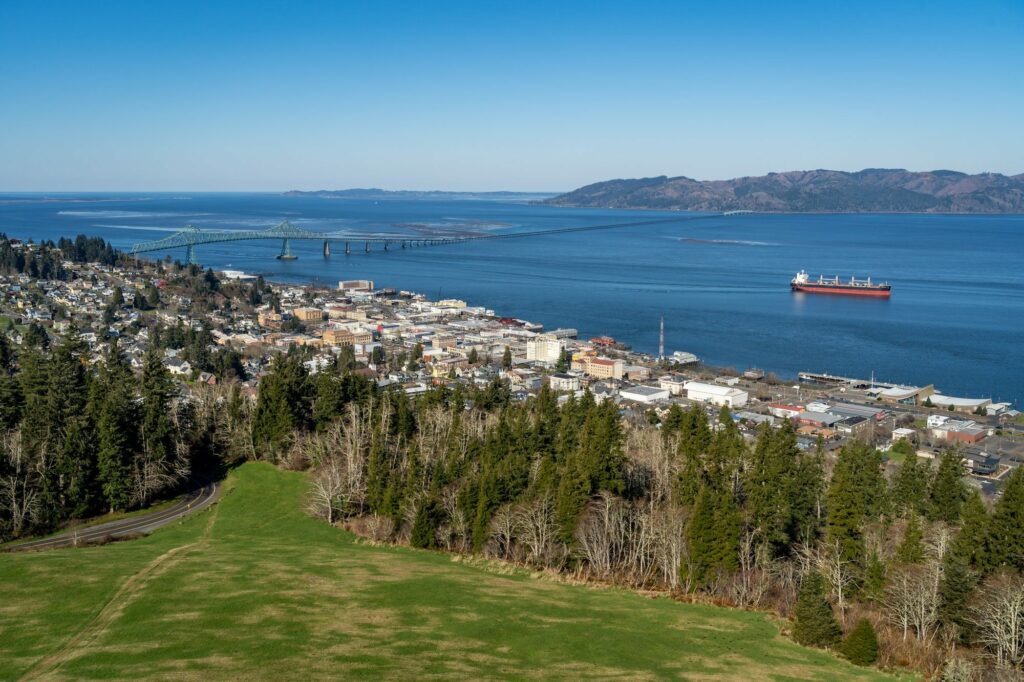
Astoria is a charming, somewhat sleepy little town at the northwestern corner of the state of Oregon.
A surprising amount of history – both American and Oregonian – happened here, including the end of the Lewis and Clark expedition and the only attack on a mainland US military base since the war of 1812.
At one point, the Astor family (who named Astoria, clearly) had big, big plans for Astoria.
Originally, because of its location at the mouth of the Columbia River where it meets the Pacific Ocean, it was thought that Astoria might become the New York City of the west.
Which, obviously, didn’t quite come to be. I (Matt) read a whole book on that doomed expedition (called Astoria), which I highly recommend.
Today, Astoria is a great place to begin your journey down the Oregon Coast.
There are a couple of wonderful parks, a stunning view from the Astoria Column, and some of the best breweries in Oregon.
What to Do Around Astoria
Here are some of our favorite things to do in Astoria, whether you’re planning on spending a couple of hours, or a couple of days in town.
The Astoria Column
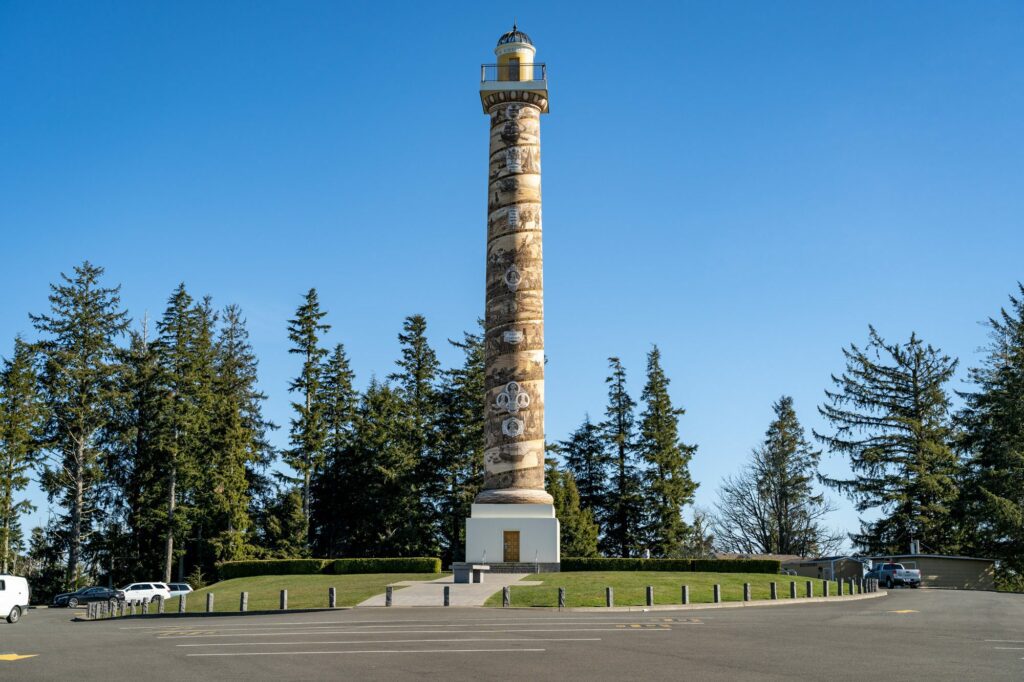
The Astoria Column is perched up on the hill above Astoria, and has sweeping views of the town, the river, and the Astoria-Megler Bridge from the top.
On the outside, there is a continuous mural depicting major events in the history of Oregon, which is pretty cool but hard to really take in without getting dizzy.
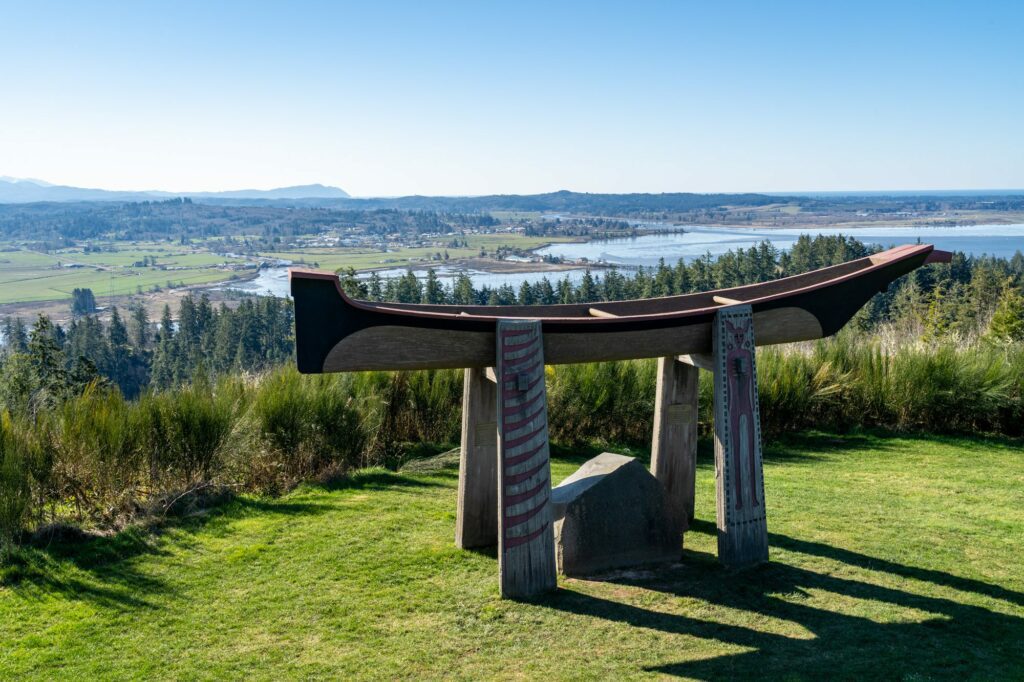
Lucky for you, you can see it online here, complete with helpful historical context about what the images mean.
Climbing the column is free, but it does cost $5 to park in the lot at the base of the column.
The Astoria Riverfront Walk
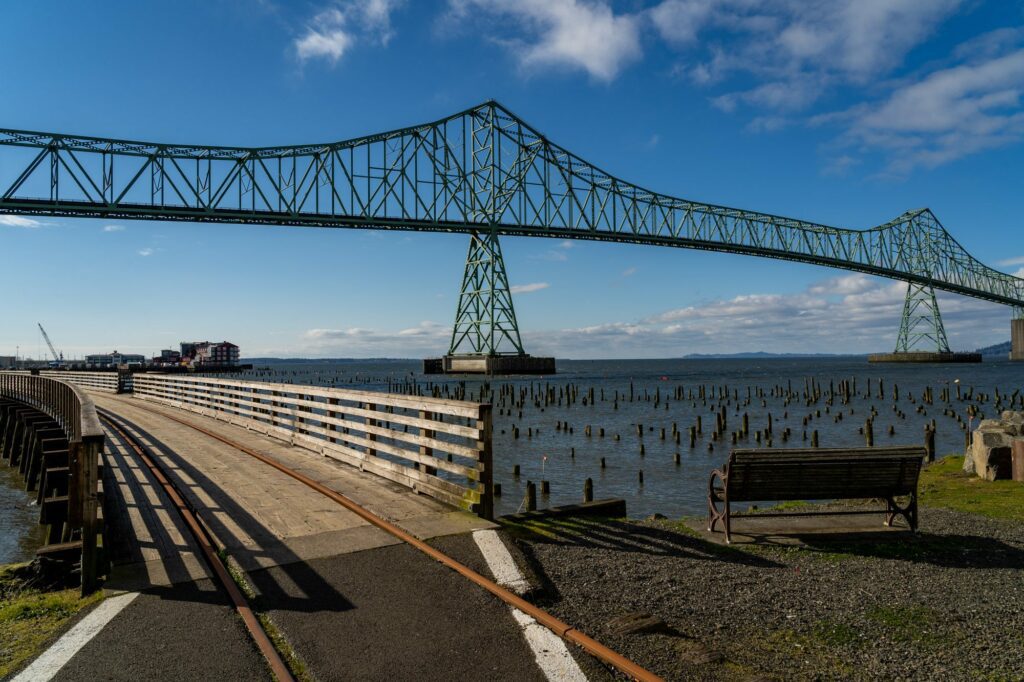
The riverfront in Astoria is full of history, and the official trail stretches 6.4 miles from the trailhead on the eastern end (here on Google Maps), heads under the Astoria-Megler Bridge, and ends at a point on the other side of town.
Keep in mind that it’s nearly 13 miles to do it out-and-back. Our recommendation would be to do a portion of it – the portion from the Columbia River Maritime Museum out to the Astoria-Megler Bridge.
It’s a nice walk past old cannery buildings, Buoy Beer, and out to a pretty stellar view of the bridge.
Along the way, you’re likely to see (or at the very least, hear) sea lions!
Breweries Galore
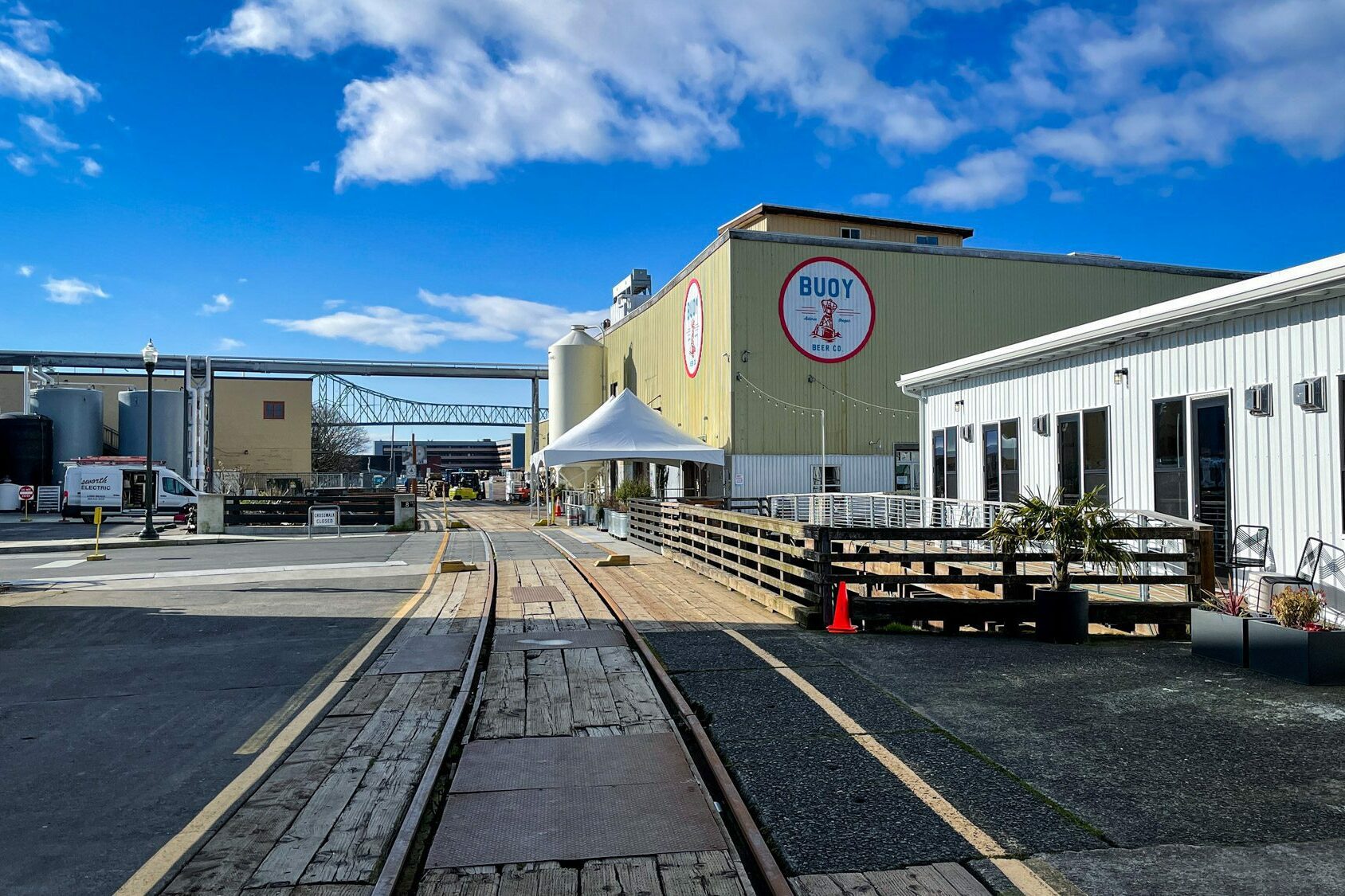
Most people talk about San Diego and Portland as the places with the most breweries per capita, but given Astoria’s small population and relatively large number of breweries, I feel like it has to be up there.
Here are a few of them:
Fort George, which has a huge taproom taking up most of an entire city block with multiple levels – including an open-air rooftop – is our top pick. They have a rotating selection of their beers on tap, along with a cider or two and (usually) gluten free beer in cans (which I very much appreciate, as someone with Celiac Disease who can’t have regular beer).
Buoy Beer is the other popular spot right on the water, though they were closed when we were in town last and have a more underwhelming non-beer selection.
The OG brewery in Astoria is Astoria Brewing Company, which started brewing beer in 1997 and has a nice industrial space on the riverfront walk.
Lewis and Clark National Historical Park
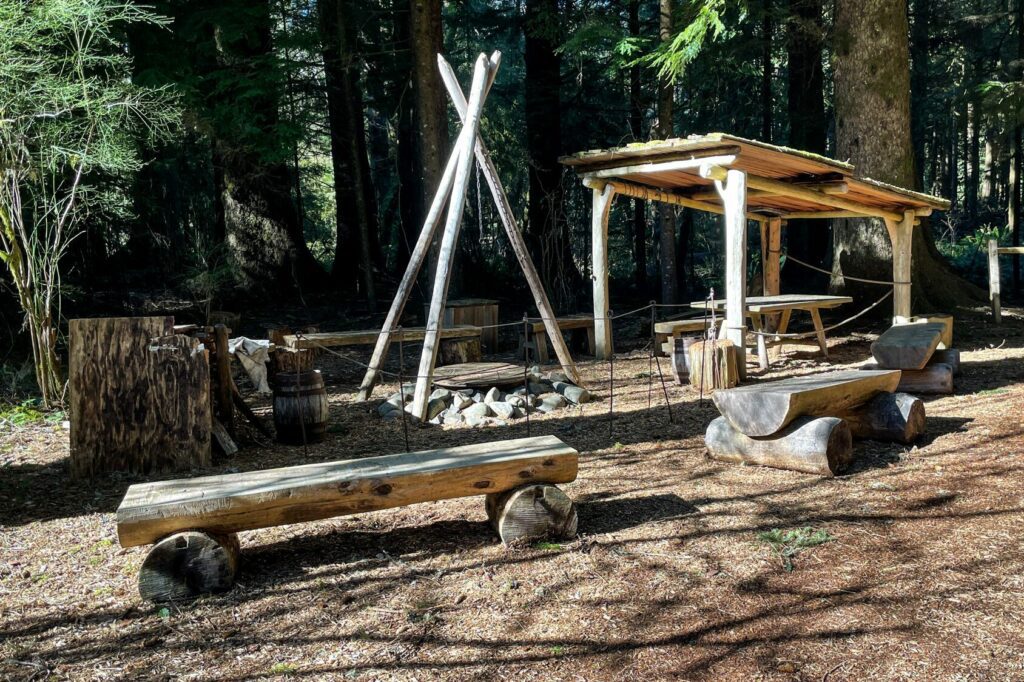
Astoria was first put on a map (by the United States government, anyway) by the famous explorers Lewis and Clark, who were commissioned by Thomas Jefferson to find the Northwest Passage that would connect them to the Pacific Ocean for direct trading routes.
At the time, it wasn’t called Astoria, but Fort Clatsop, and it was about five miles southwest of the city as we know it today.
The expedition spent three (miserable, it sounds like) months experiencing a very wet Pacific Northwest winter in 1806 before triumphantly returning to St. Louis, their mission complete.
We’d focus your time on two pieces of living history: Fort Clatsop and the Fort-to-Sea Trail.
It’s $10, or free if you have an America the Beautiful Pass or an Oregon Pacific Coast Passport.
Fort Stevens State Park
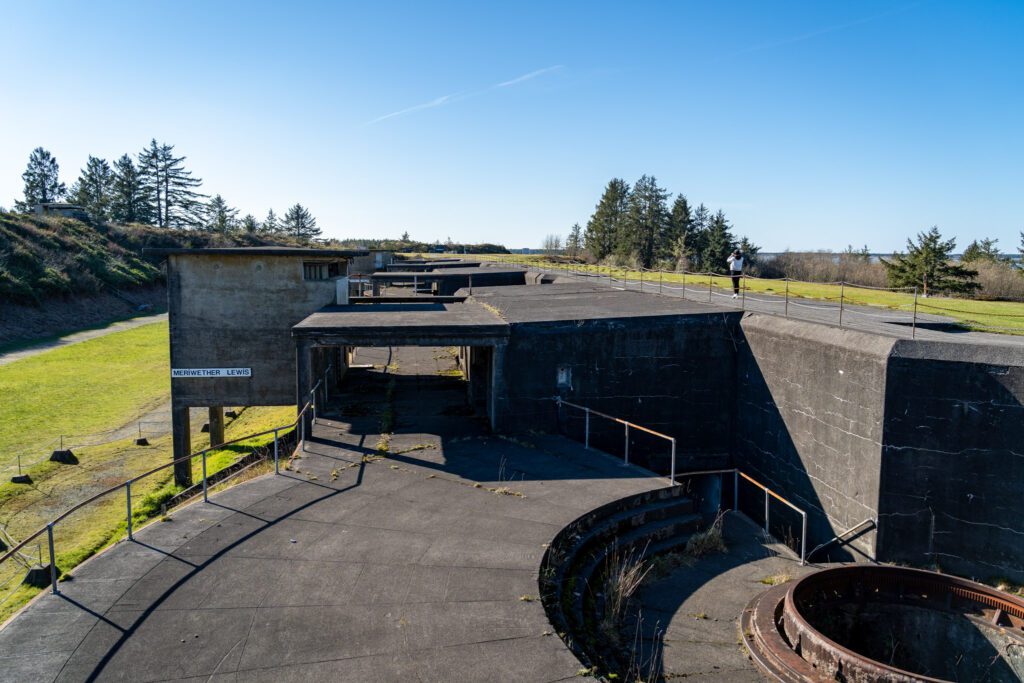
Fort Stevens State Park occupies some prime real estate at the northwestern corner of Oregon, where the Columbia River meets the Pacific Ocean.
The fort was constructed at the tail end of the Civil War to prevent enemy ships from gaining access to the Columbia River, and remained in operation until the 1940’s.
There are two places in particular that we’d encourage you to visit as you do some exploring.
The Peter Iredale Shipwreck: Probably the most famous piece of the park, the Peter Iredale ran ashore in 1906 as it was trying to navigate the famously treacherous waters of the mouth of the Columbia River and has been there since.
It’s right on a long, sandy stretch of beach – which is a welcome change from the rocky beaches we have up in Washington – and it’s a lovely place to spend a sunset.
The Northwest Corner of Oregon: Up to the north, you’ll find Clatsop Spit, which marks the northwestern-most point in the state of Oregon.
There are a couple of parking areas up on the spit, and we thought parking lot C (here on Google Maps) was the best because of the view of the beach and coast to the south from the tower near the parking lot.
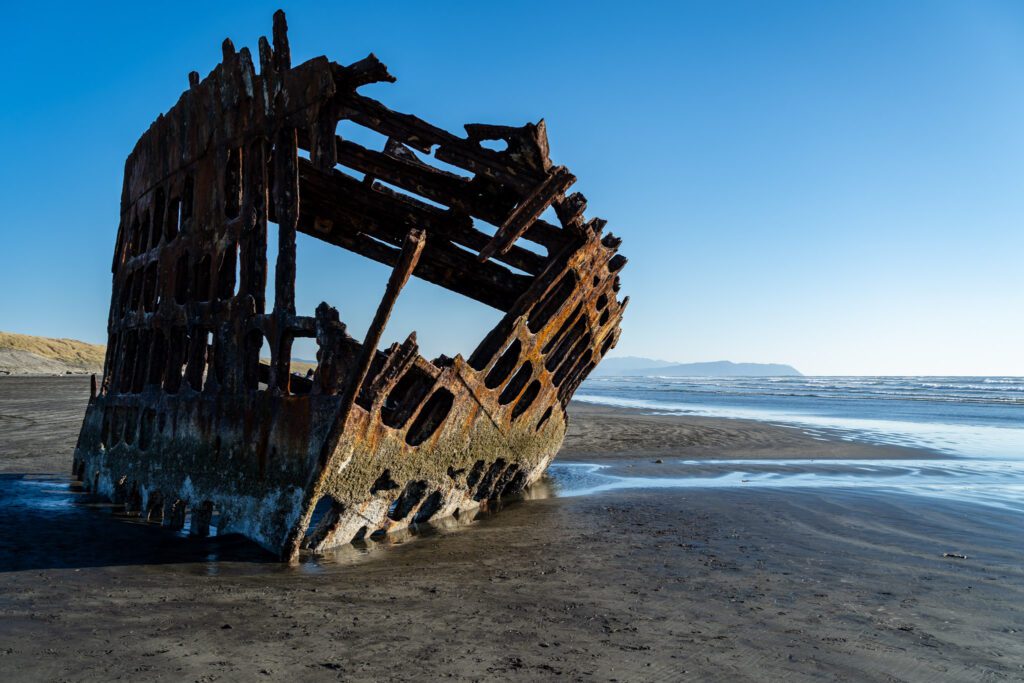
For more on what to do and see in Astoria, make sure to read our more detailed guide to the best things to do in Astoria!
Days 2-3: Cannon Beach & Around
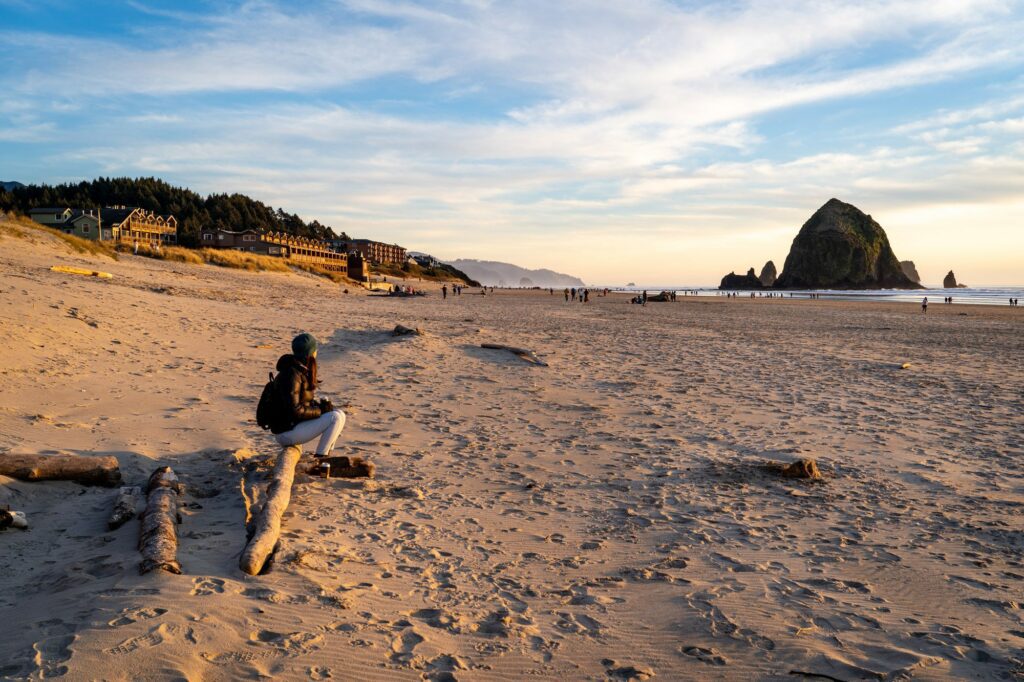
Cannon Beach is perhaps the most famous of the northern Oregon Coast towns, primarily for two reasons.
Its proximity to Portland is the first. At just over 90 minutes away, it’s a perfect day trip from Portland if you’re looking for some beach action (or when it’s a billion degrees in the city).
Second is Haystack Rock, which is featured prominently in every Pacific Northwest photographer’s Instagram and portfolio.
The town of Cannon Beach is charming and a little bit cheesy, but is an excellent stop on your road trip as a home base for exploring the state parks immediately north and south of town.
If you’re familiar with the Oregon Coast at all, you’ll notice that we completely skipped Seaside.
After poking around Seaside for an afternoon, we decided that basically anything you can find in Seaside you can find in other places on this itinerary.
And by and large, whatever “things” we’re talking about are generally done better elsewhere on the coast.
For example, the aquarium. The Seaside Aquarium is tiny. If you’re in the mood for an aquarium and you’re making it down to Newport, hold out for the Oregon Coast Aquarium in Newport, which rivals the Monterey Bay Aquarium in California for the best we’ve ever been to.
We do like the idea of the Funland Arcade and the bumper cars across the street, though.
But overall, we think your precious time is better spent elsewhere. Some people probably love Seaside (especially if you have kids), but it wasn’t our thing.
Anyway, back to Cannon Beach, which is a similar idea to Seaside in that it’s a coastal resort town whose population balloons in the summer as people escape to the coast, but is much, much more inviting and charming.
What to Do Around Cannon Beach
Here’s what we’d do in and around Cannon Beach.
Head Out to Ecola State Park
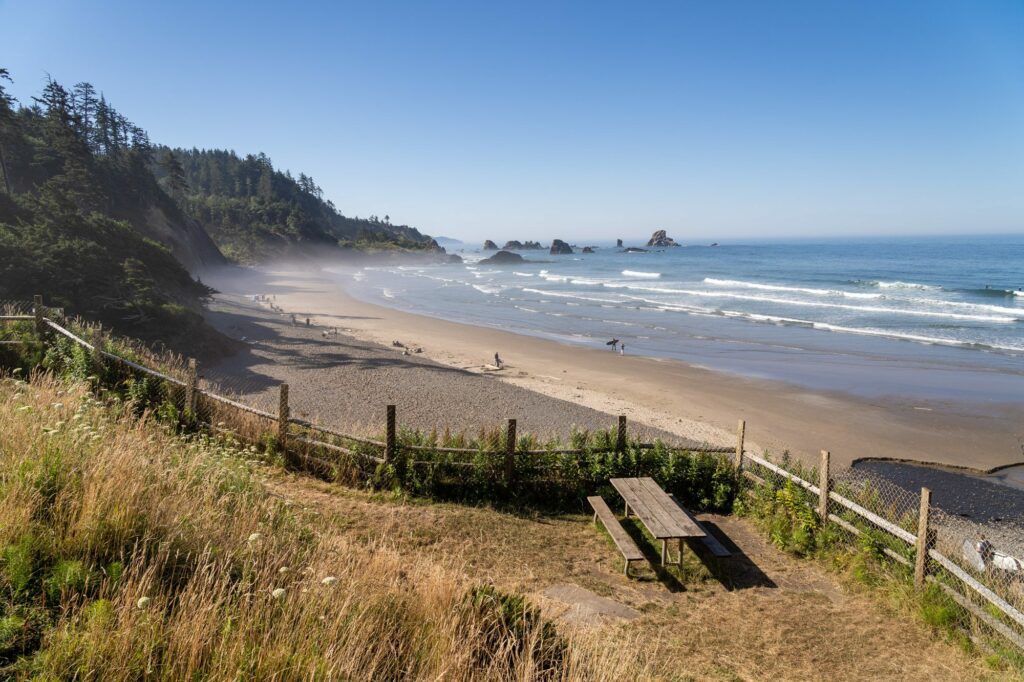
We had never been to Ecola State Park until our fifth trip out to the coast – though we’d wanted to each of the four previous times.
The reason? Storm damage had it closed since early 2020 (You can check the current park conditions here).
But if that road out to the park is open for your trip, you definitely should for the incredible views out over Cannon Beach, with its crashing waves and towering sea stacks.
The park covers the area around Tillamook Head, which the Lewis and Clark expedition famously climbed, later writing about the panoramic coastal views (and the really, really hard climb).
Here are Clark’s words about the views, in case you’re not sure if you should make the stop or not: “… the grandest and most pleasing prospects which my eyes ever surveyed.”
We love Indian Beach, and have spent a sunny day there escaping the 100+ heat in Portland with friends.
Highly recommended if it’s brutally hot in the city – it’s a solid 20+ degrees cooler near the ocean.
We’d also head down to Crescent Beach, which is accessible via a mile-long trail (one way) from the main parking lot (here on Google Maps), this hike takes you down to a nice, secluded beach on the south end of the park.
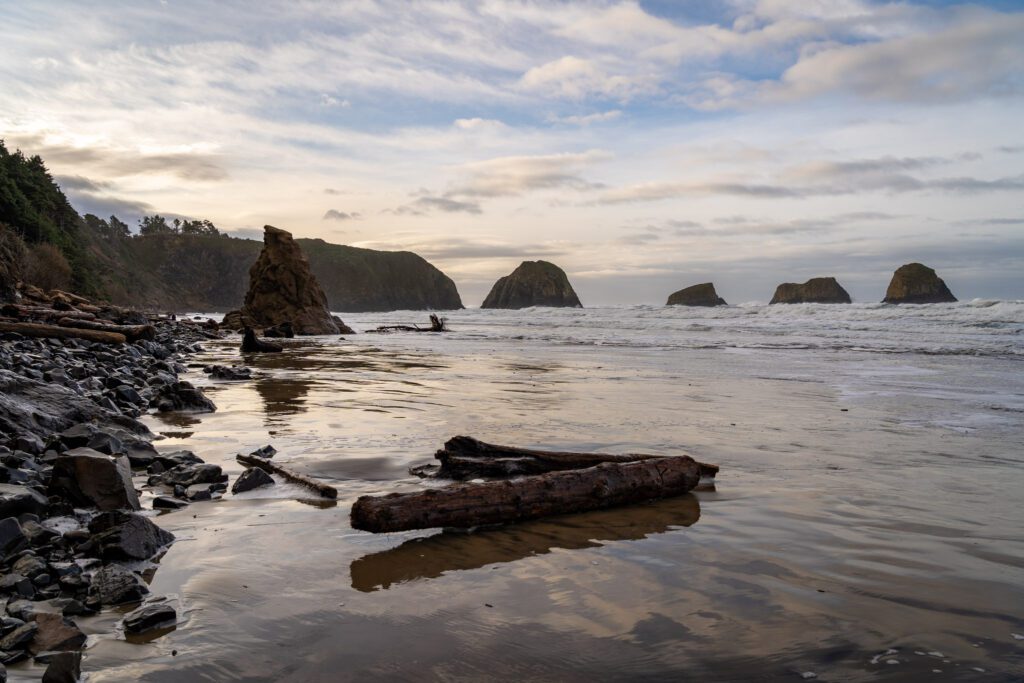
Explore Oswald West State Park
The second of the great Oregon State Parks near Cannon Beach, this one has three things worth checking out.
First is Short Sand Beach, which is heaven for surfers. Even on a rainy, stormy day you’re bound to find at least a couple of dedicated surfers sitting in the water.
Next is the Cape Falcon Trail, which takes you out onto the cape above Short Sand Beach.
This is the muddiest hike we’ve ever done. It’s relatively easy, but I’m not joking when I say that it’s one of the muddiest hikes we’ve ever had the privilege of doing (in the summer!). Prepare accordingly.
Last but not least is the Neahkahnie Mountain Trail, which is probably our favorite of the hikes in Oswald West State Park. And it’s really just because of the vista at the top, which includes a view of Manzanita Beach stretching endlessly south.
There are multiple ways to do this hike, and the most popular version is to start from the northern trailhead, which is right off of 101. This is also the longer, harder version of the hike.
The alternate option is to go from the south trailhead, which is a half mile off of 101 up a narrow forest road, which cuts the distance to 2.6 miles and 850 feet of elevation gain.
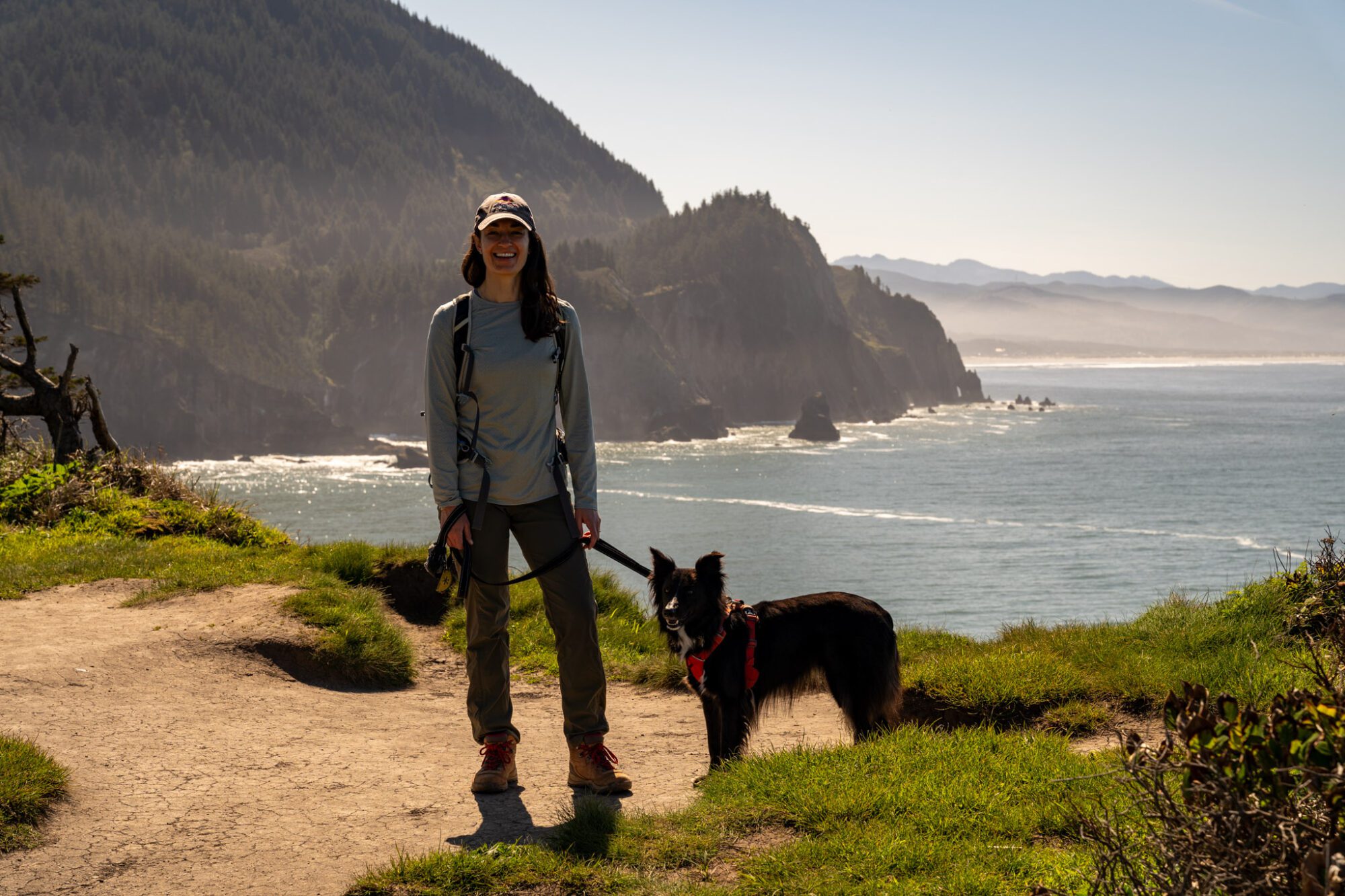
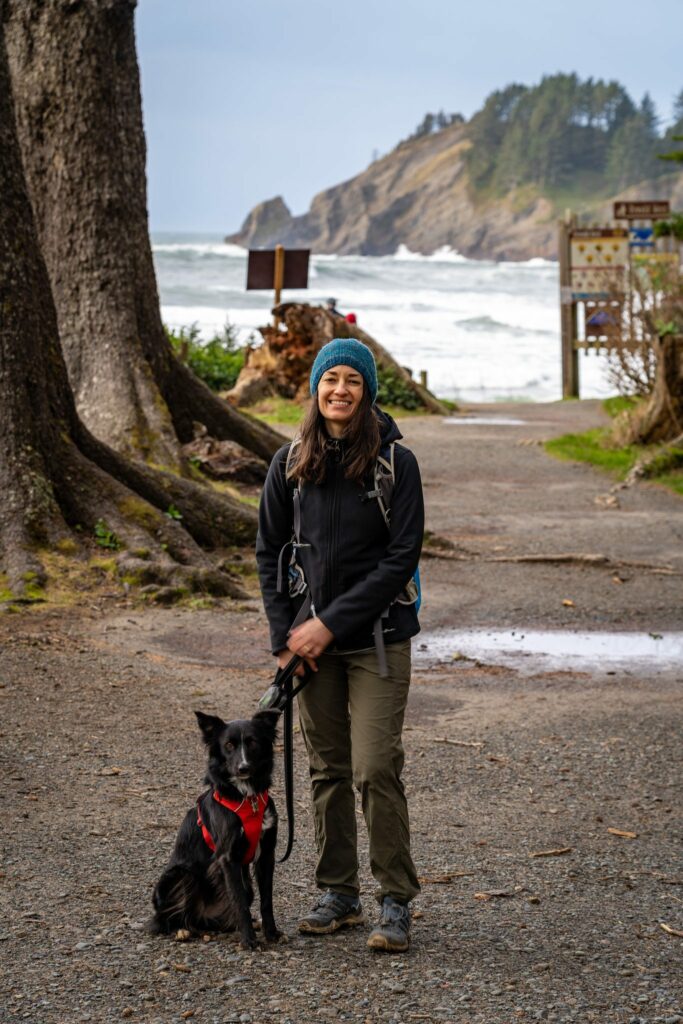
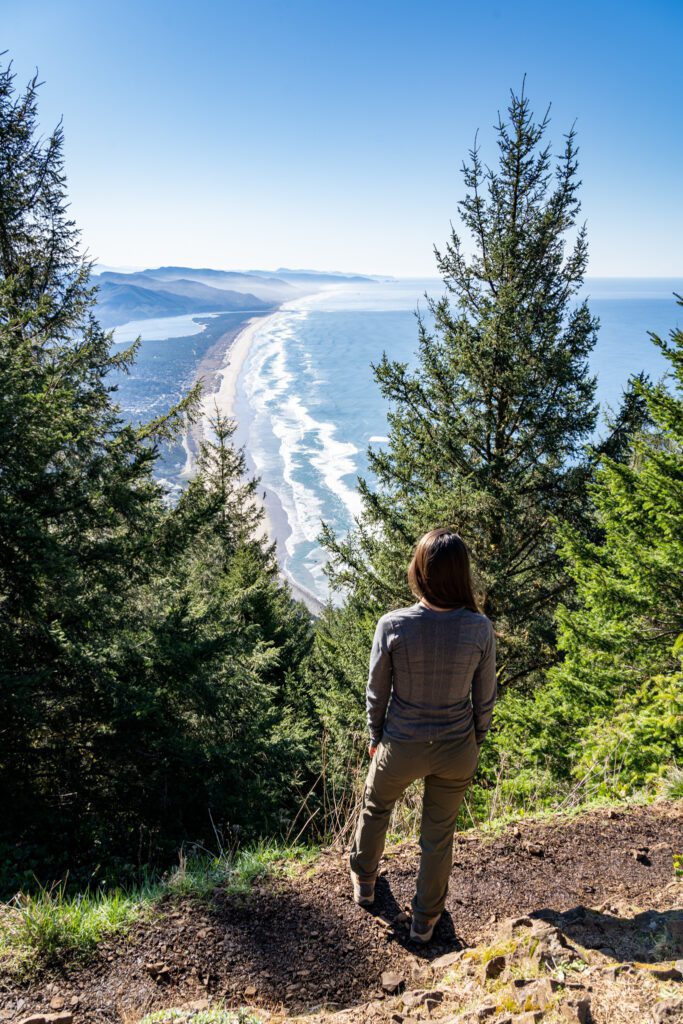
Explore the Town of Cannon Beach
The town of Cannon Beach itself is…fine. For us, it’s all about the access to the natural beauty nearby, and we don’t spend much time at all in town.
Here are some things to do around Cannon Beach.
Public Coast Brewing: Local beer, and gluten free fish and chips (though you’d never know it!) at the northern end of town near the entrance for Ecola State Park. A perfect post-hike refuel stop!
Haystack Rock: Perhaps the most famous scenery on the entire Oregon Coast, Haystack Rock is a giant sea stack just off of the coast on Cannon Beach that towers over the surrounding area. It’s an excellent sunset location! There’s also a puffin colony that calls the rock home, which is fun to learn about from the rangers on the beach.
Good Coffee: If you’re in the mood for some good coffee, head to either Insomnia Coffee Co. or Sea Level Bakery + Coffee. Insomnia is right in town, Sea Level is about ten minutes south on the way to Oswald West State Park (and Sea Level is our top pick of the two).
Hug Point: First of all, this is only a low tide place to visit, because when the tide is out, this is a huge stretch of beach with all sorts of fun tide pools that is really only accessible at low tide. Check tides here. The parking lot is small, which means you’ll want to either get here early in the morning (again, depending on tides!) or be prepared to wait for a parking spot if you’re here on the weekend.
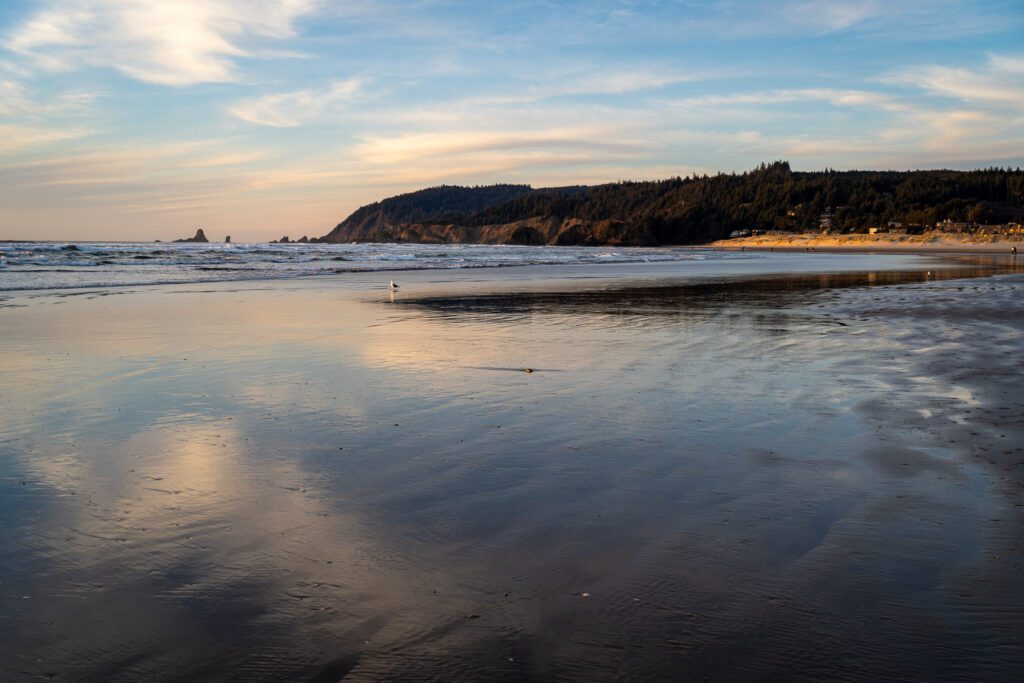
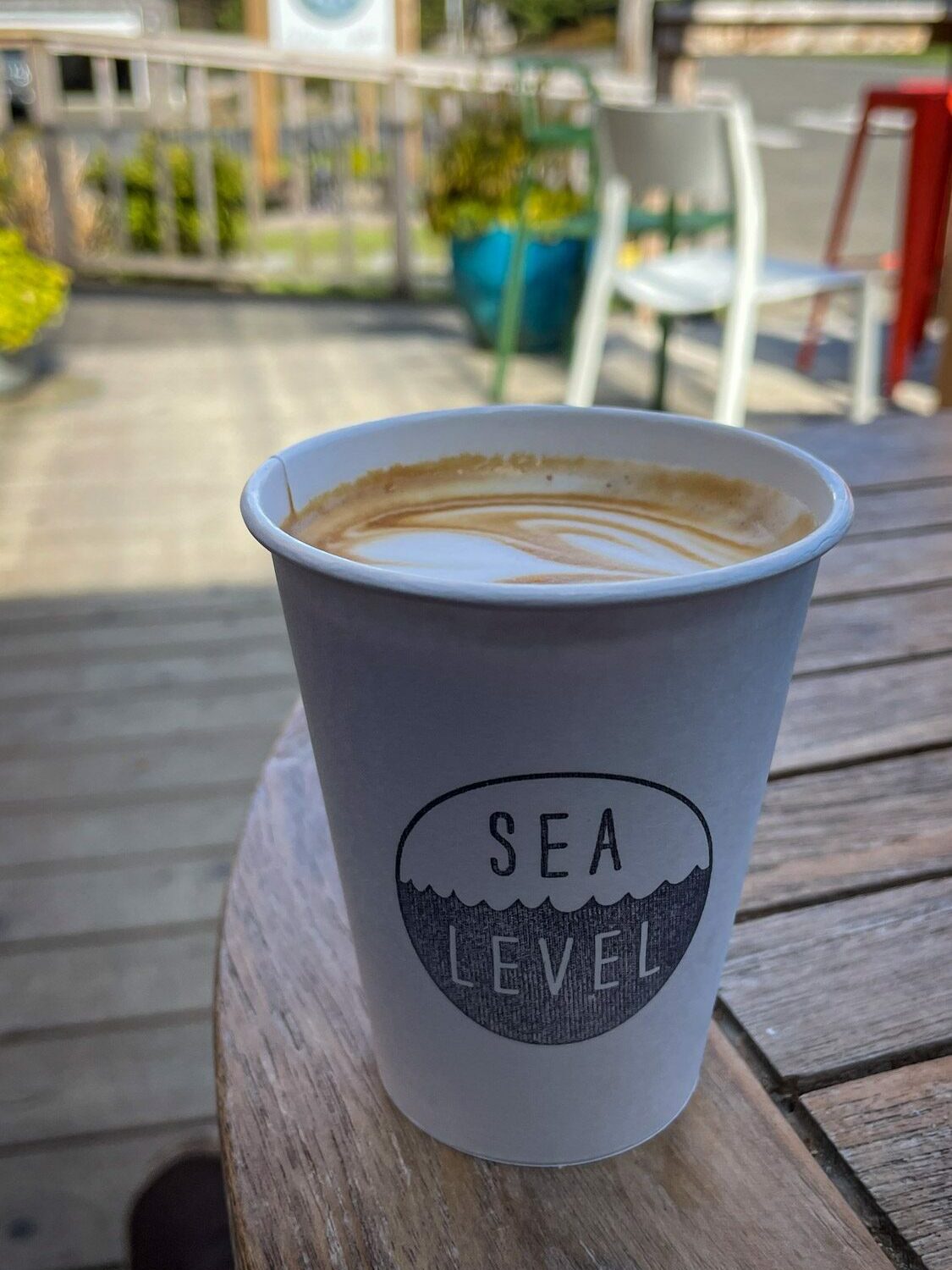
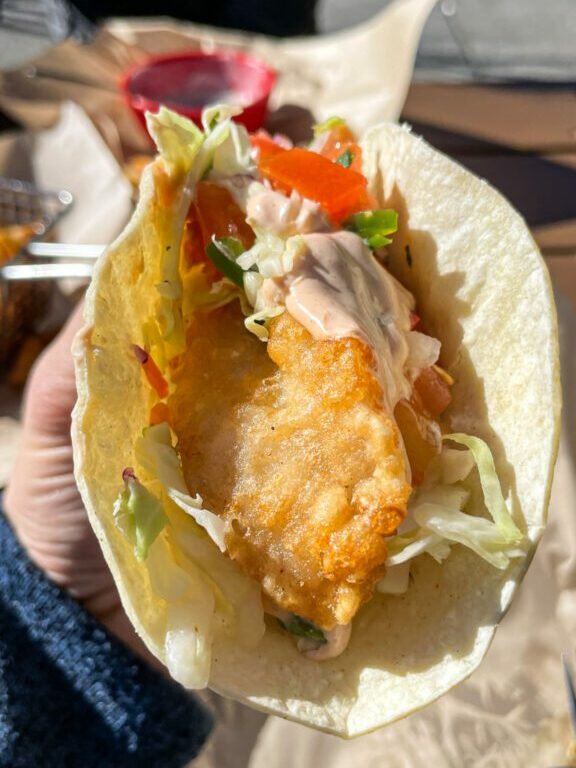
Days 4-5: Tillamook & Around
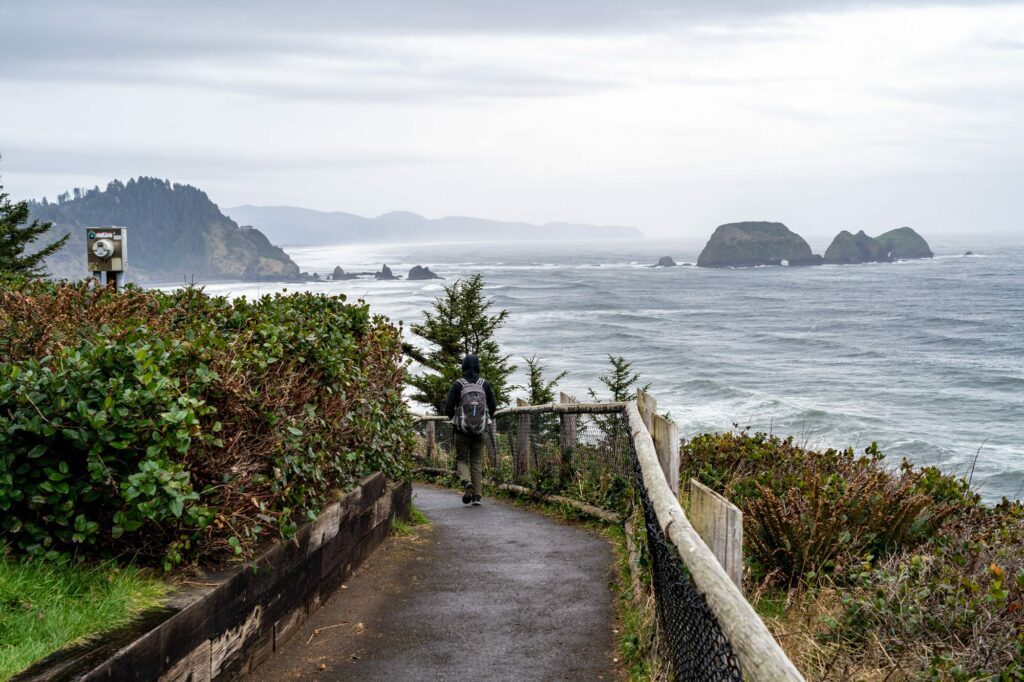
The town of Tillamook itself is fine, but the real beauty of Tillamook is the wealth of incredible nature that is accessible within 30 minutes or so.
If you’re short on time, driving the Three Capes Scenic Route is a must-do (and you could do it as a one-way drive on your way south).
Oh, and the cheese. There’s not one but TWO places to get amazing cheese in Tillamook (more on that in a second).
What to Do Around Tillamook
Here are a few things to do in Tillamook that should keep you busy for a day or two.
Devour Delicious Cheese!
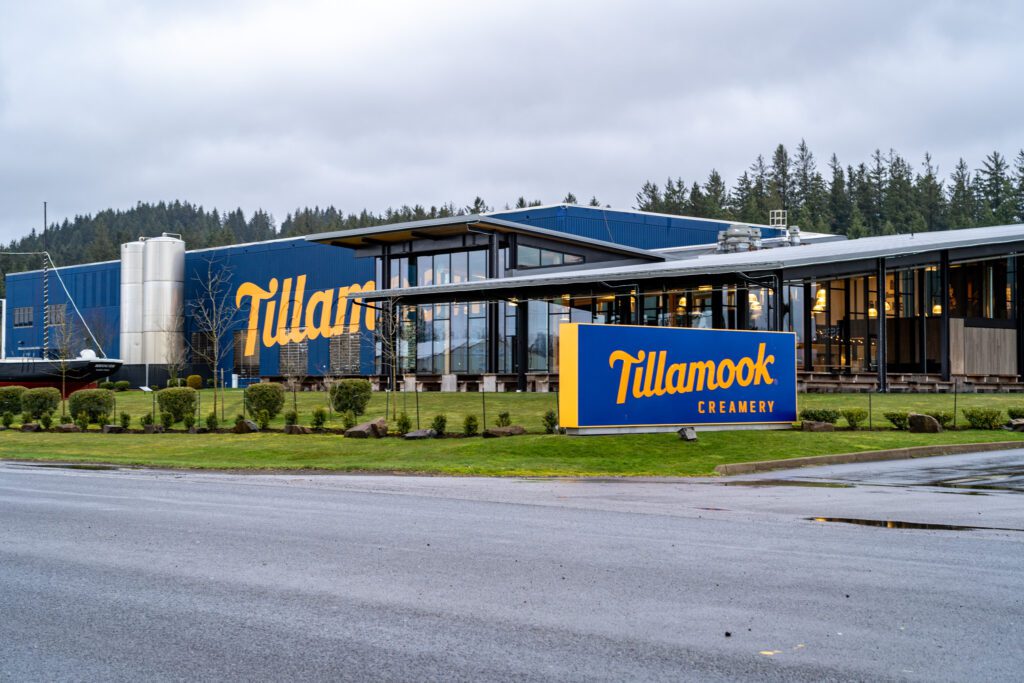
There are two great places to get farm-fresh cheese in Tillamook. The most famous (and our personal preference) is Tillamook.
Whether or not you’re familiar with the Pacific Northwest, you’ve likely had Tillamook cheese before.
But I’m not sure how many people have had the pleasure of tasting their ice cream, which is some of the creamiest ice cream we’ve ever had.
It’s not gluten free, but Alysha loves it (their chocolate peanut butter ice cream is legendary).
At their factory, they have an ice cream bar with all sorts of different unique flavors, along with some unique cheeses that you can’t really find elsewhere.
Plus, cheese curds!
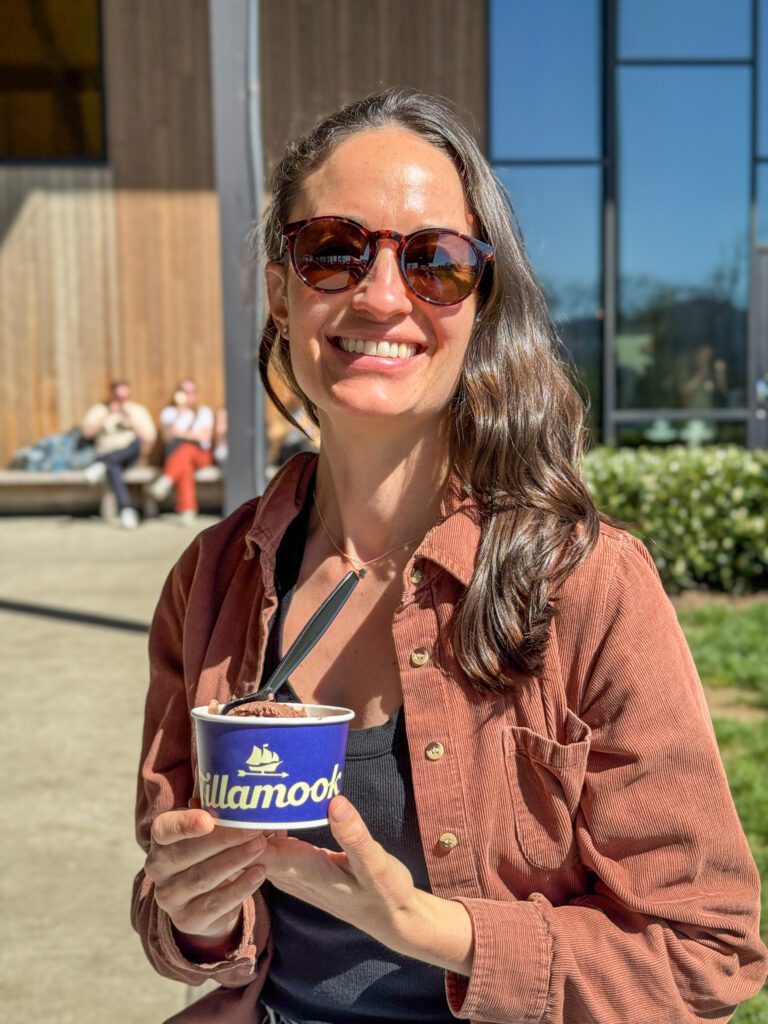
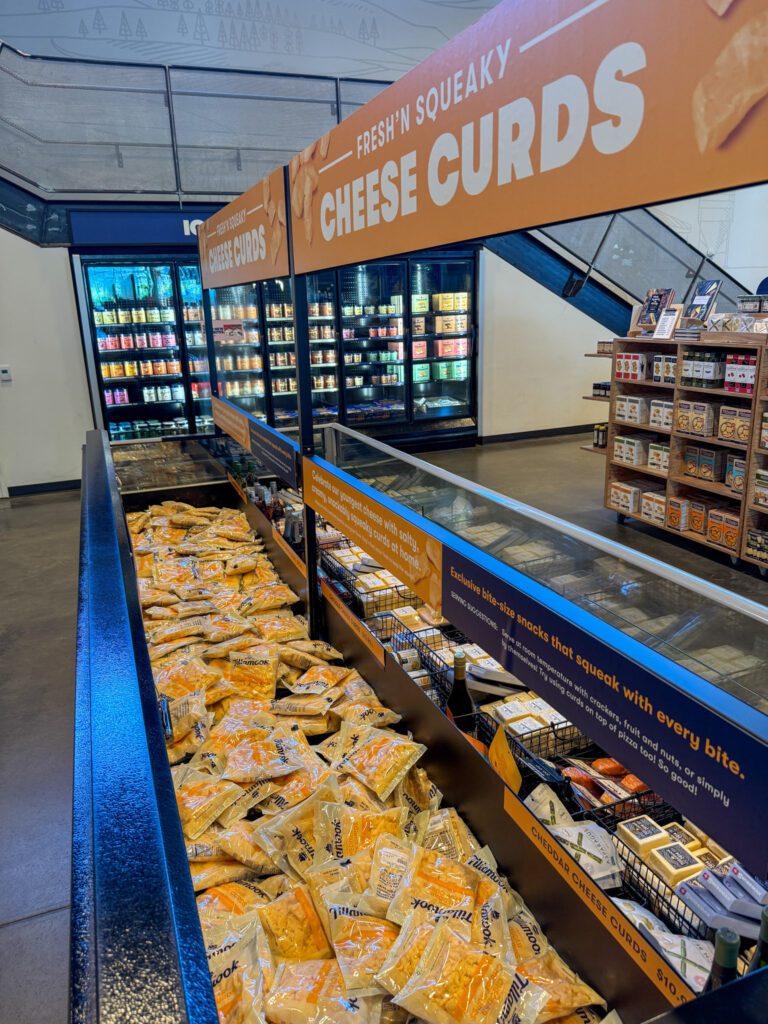
Blue Heron is just down the road, and specializes in French cheeses (think Brie) – we loved their herb Brie.
Drive the Three Capes Scenic Route
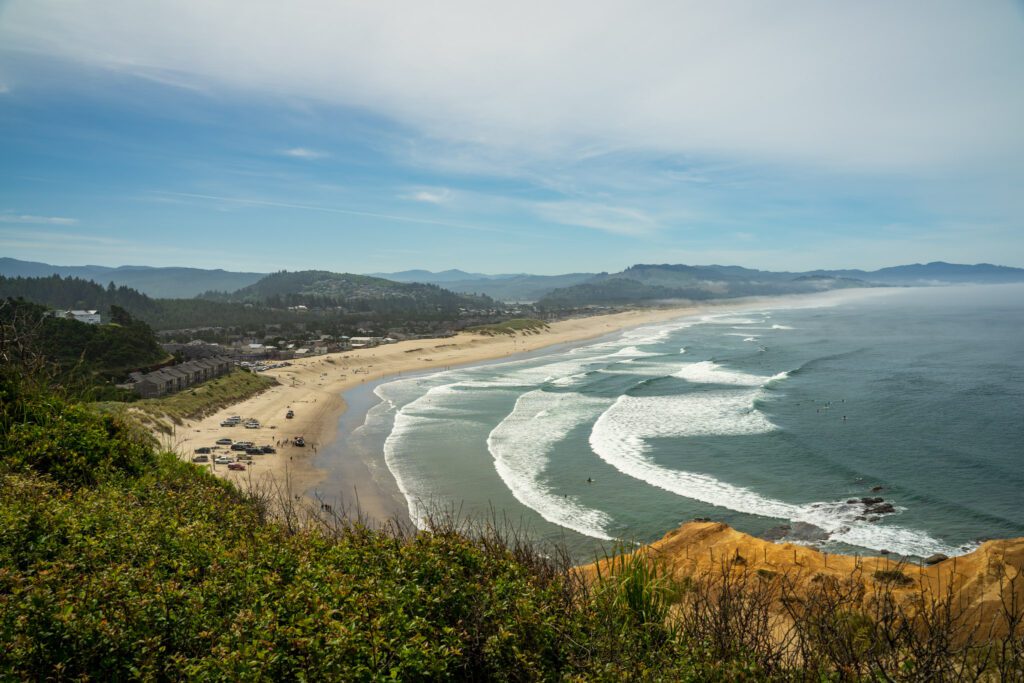
This drive takes in, you guessed it, three different capes.
You’ll start at Cape Meares, make your way south to Cape Lookout, and then head down to Cape Kiwanda.
Here are more details on those stops.
Cape Meares: You’re mostly here for the lighthouse, which is hard to photograph, but the walk up to the so-called “Octopus Tree” is also worth the quick detour. Throughout the park you have really nice rugged coastal views.
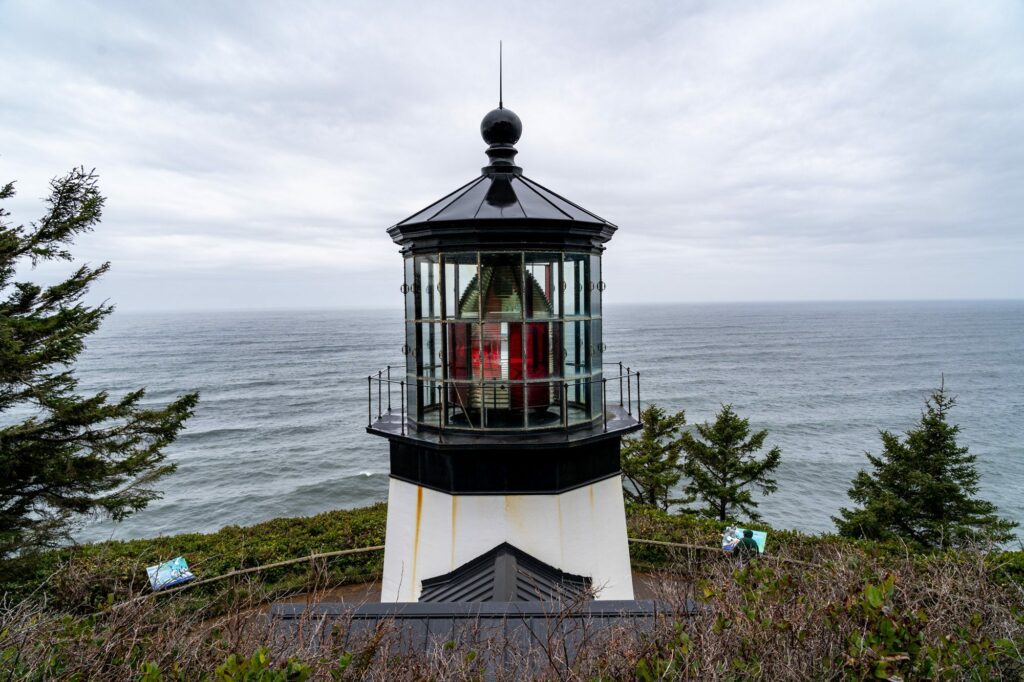
Cape Lookout: Probably our favorite of the three capes, there are two main things to check out here.
First is the beach, which is accessed by parking at the lot here.
Second is the Cape Lookout Trail, which takes you out to the end of the Cape (through a nice temperate rainforest, I might add) where amazing coastal views are waiting for you.
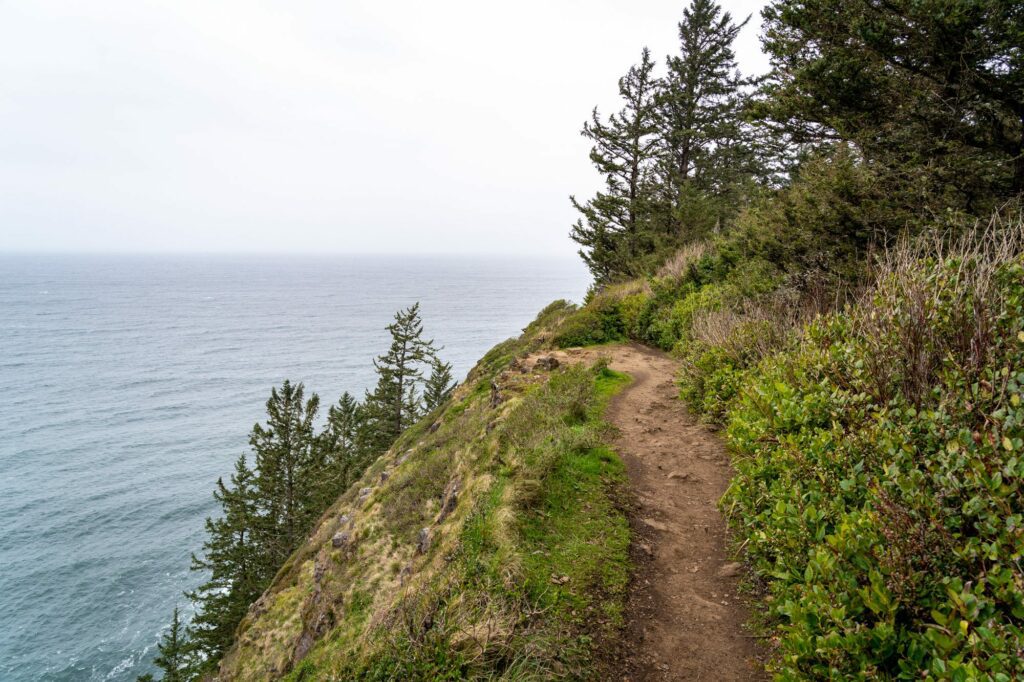
Cape Kiwanda: Furthest south, Cape Kiwanda is another great surfing spot, and you’ll routinely find many, many surfers out in the water. You can also drive out onto the beach here, which is fun (though we didn’t dare in our minivan).
The highlight here is the hike up on the sandy headland on the right (that’s north) side of the beach.
There are great views of Cape Kiwanda from the top, but there are also some nice views back to the north on the other side.
It’s also worth stopping for food or coffee at Stimulus Coffee & Bakery, which is across the street from the main parking lot. The coffee is excellent, and though I can’t speak to the baked goods (I have Celiac Disease), the line tells me they’re probably pretty good.
Days 6-7: Newport & Around
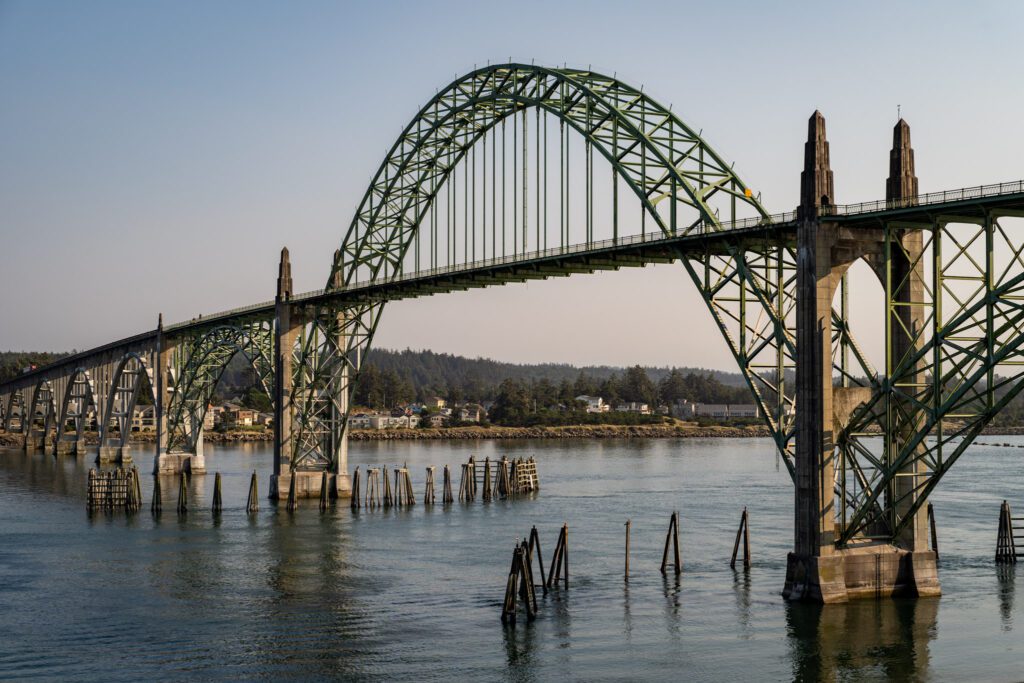
To us, Newport very much feels like a midpoint on the Oregon Coast. Both in terms of geography – it’s right around the middle of the trip down the coast – but also in terms of vibes.
It’s the last bigger city (town?) on the coast if you’re heading south, and there’s a surprising amount of bars, restaurants, shops, and other amenities that you might find in a city.
But you get outside of town to the south and it very quickly becomes the rugged, wild southern Oregon coast as you make your way towards Cape Perpetua.
Newport is worth an overnight stop, since you’ll have a drive of a couple of hours coming from Tillamook, and another couple of hours before you reach your next stop after you pass through Newport.
Plus, it’s a nice place to hang out, and it’s worth spending an afternoon and evening exploring the Bayfront, where you’ll find a fun stretch of bars, breweries, and restaurants to peruse.
What to Do Around Newport
Newport is one of the biggest towns / cities on the Oregon Coast, so it has a lot going on.
Explore the Town of Newport Itself
Newport itself is worth exploring, with a nice lighthouse and a historic wharf (with sea lions) that are worth a stop.
Yaquina Head Lighthouse: A must-stop just north of Newport, this is a beautiful lighthouse perched on a head at the northern mouth of Yaquina Bay.
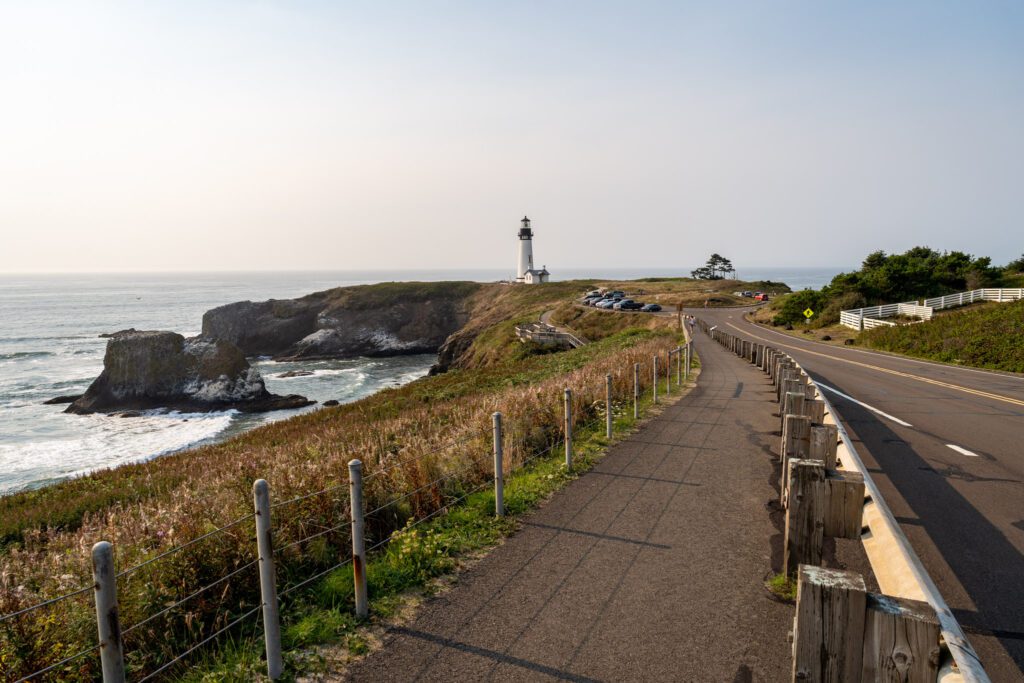
It’s a short walk out to the lighthouse from the parking area, but you should also try to walk down to the beach on the north side (both Cobble Beach and Quarry Cove).
There’s an extensive visitor center here too.
Nye Beach: The best beach in Newport! Splurge on a dinner at Zach’s Bistro if you have the chance (they have plenty of gluten free options!). Agate Beach – which Matt learned is not pronounced “Ah-gah-tay” but “Agitt” – is another good one, just north of town.

The Oregon Coast Aquarium: This is probably the best aquarium on the west coast aside from the Monterey Bay Aquarium. We had every single intention of going here.
Until, that is, we showed up on a weekend afternoon and realized that it was the busiest time possible, with hordes of screaming kids making their way towards the entrance.
So we decided to skip it. But that doesn’t mean you should!
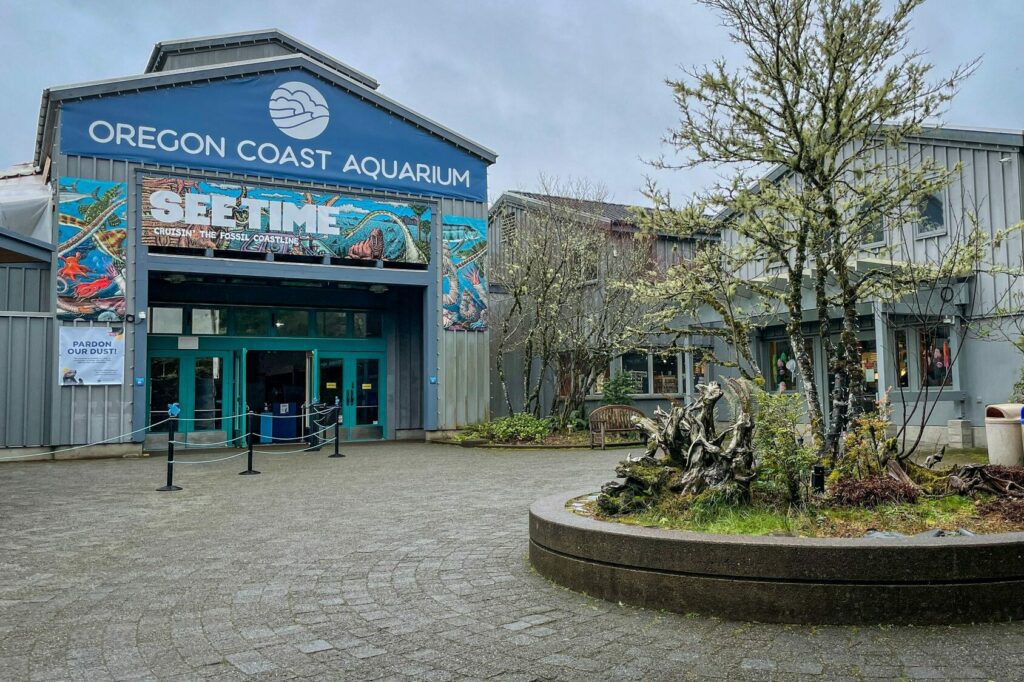
It’s a little expensive at $25 per adult, but if you’re interested in the marine life on the coast, it’s worth it.
If you want to see what you’re getting yourself into, they have a bunch of live cams where you can see the enclosures for the otters, sea lions, etc. More information here.
Food and Drinks in Newport: It’s definitely worth making your way to the Historic Bayfront in Newport while you’re in town (here on Google Maps) – it’s charming and vibey, and they’ve done a pretty good job with it over the past few years.
A couple of notable spots are Mo’s Seafood and Chowder (for the, well, seafood and chowder), Clearwater (for a nice dinner with views of the Yaquina Bay Bridge), and if you’re looking for a drink, Newport Brewing Co.
Hiking in Lincoln City
Lincoln City is on this list because it’s home to not one, but TWO of our favorite hikes on the Oregon Coast.
It’s a sleepy resort town about 45 minutes south of Tillamook, and other than these two hikes there’s not really that much to do or see nearby.
There’s a wide, sandy beach, which is nice, but to be honest, there’s a lot of those on the Oregon Coast.
For us, it’s all about the hikes. And it would make a fantastic stop to break up the drive between Tillamook and Newport, your next main stop.
Option 1 – Cascade Head: The first is Cascade Head (from the lower trailhead), which takes you up a steep set of stairs and through a dense forest before emerging onto a headland with spectacular coastal views.
Continue climbing past a lower viewpoint up the ridge to the upper viewpoint for even better views, which you might not believe is even possible. We did this hike on a very stormy, windy day in February, and we still enjoyed it!
There are a couple of ways to do this hike, and the easiest and most direct is to drive most of the way up to the upper trailhead, which results in a shorter, easier hike.
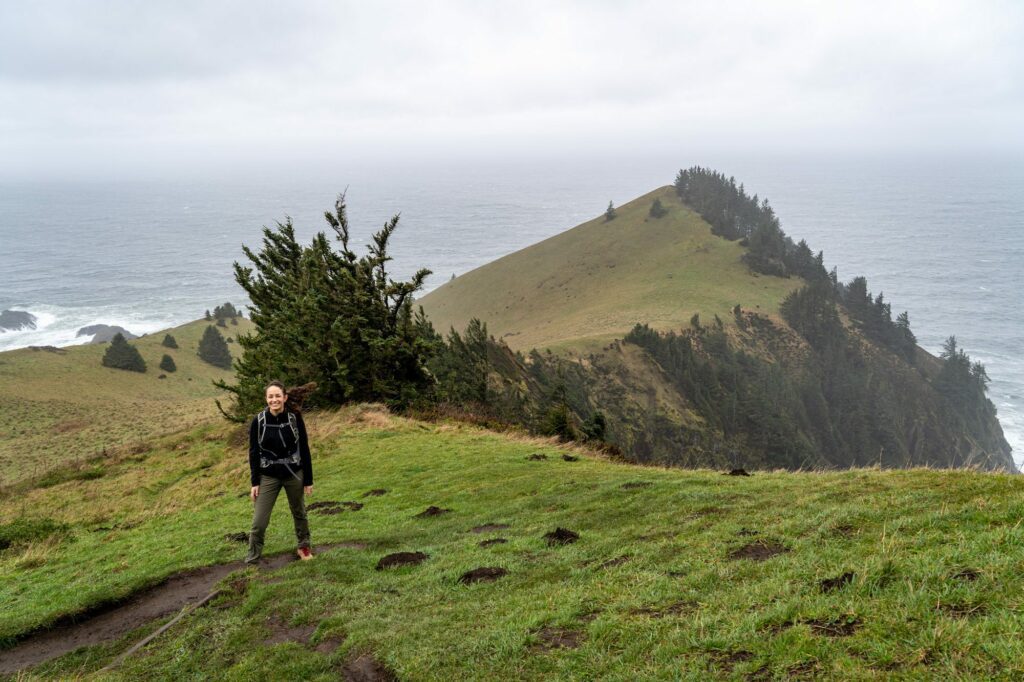
Option 2 – God’s Thumb: The second hike here is God’s Thumb, which takes you out to a cool, for lack of a better word, natural terrace with great ocean views.
The last part of this trail gets a little sketchy, as you’re climbing on a narrow trail with steep drop offs to reach God’s Thumb. Only do what you’re comfortable with, and be careful when it has been raining and this part of the trail is muddy.
From the top of the Thumb, you have pretty spectacular coastal views awaiting you. This would be an excellent sunset hike, where you’ll be awash in a soft golden glow as the sun sets over the Pacific to the west.
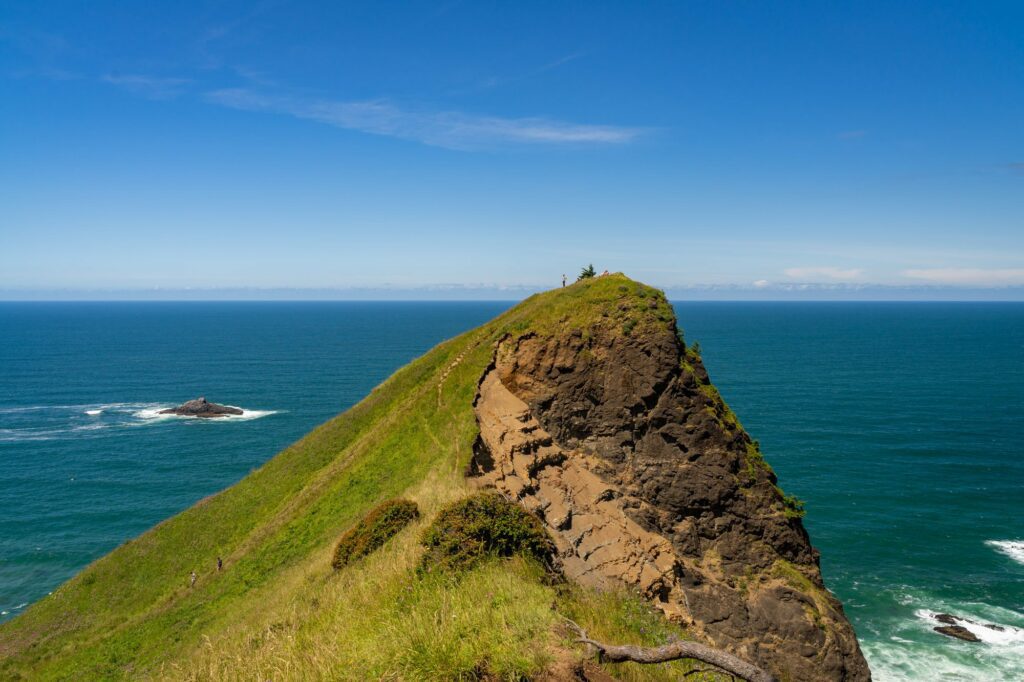
Scenic Drive through Cape Perpetua
This is probably best done on your drive between Newport and the southern coast, but it’s one of the most scenic drives in the state.
The stretch from Cape Perpetua to Heceta Head Lighthouse is probably our favorite part of the Oregon Coast, and reminds us of the drive from San Francisco to Los Angeles through Big Sur.
Cape Perpetua is a big bluff that rises almost 1,000 feet out of the ocean below, which means from the scenic viewpoint at the top, you have an incredible view of the never ending coast to the south.
It’s a narrow, winding two lane road, but the slower pace that comes with that will allow you to really soak up the views along this stretch. Here are some stops to make along the way.
Devil’s Churn: A short stop where you’ll hike down to an overlook with a view of an inlet that is partially covered at the end. Which means at high tide, if you’re lucky, the waves coming in will meet the waves going out and create an explosion of water.
Cape Perpetua Lookout: This lookout (here on Google Maps, pictured above) is the best view on the Oregon Coast. In our opinion, anyway.
For some reason, the first time we drove the Oregon Coast, we thought you had to hike here to get this view via the Saint Perpetua Trail.
Imagine our disappointment when we realized upon arrival at the top that you could just drive here (the trail is still a good workout, though we’d probably just drive next time).
Anyway, from the top, you get a nice view of the rolling waves and coastline below, and we definitely think it’s worth the stop.
Thor’s Well: This is a cool spot just south of the access road up to the viewpoint. You’ll take a short walk out to the shore, where you’ll find Thor’s Well.
What, exactly, is Thor’s Well? The current thinking is that it’s a collapsed sea cave, but nobody really knows.
What we do know is that it’s worth the short detour to see the “well” fill up as the waves come crashing over the shore, and then slowly drain through a hole in the sea-facing wall.
You should know that there’s really nothing to see here at low tide – we’re speaking from experience – the best time to visit is right before or after high tide, when the water comes up over the edge of the well and drains when the tide recedes. Check tides here.
Heceta Head Lighthouse: We’ve now officially left Cape Perpetua, and are about 15 minutes south.
This is one of the best lighthouses on the Oregon Coast (it’s about even with Yaquina Head in Newport, we think), sitting hundreds of feet above the ocean looking out from its perch on Heceta Head.
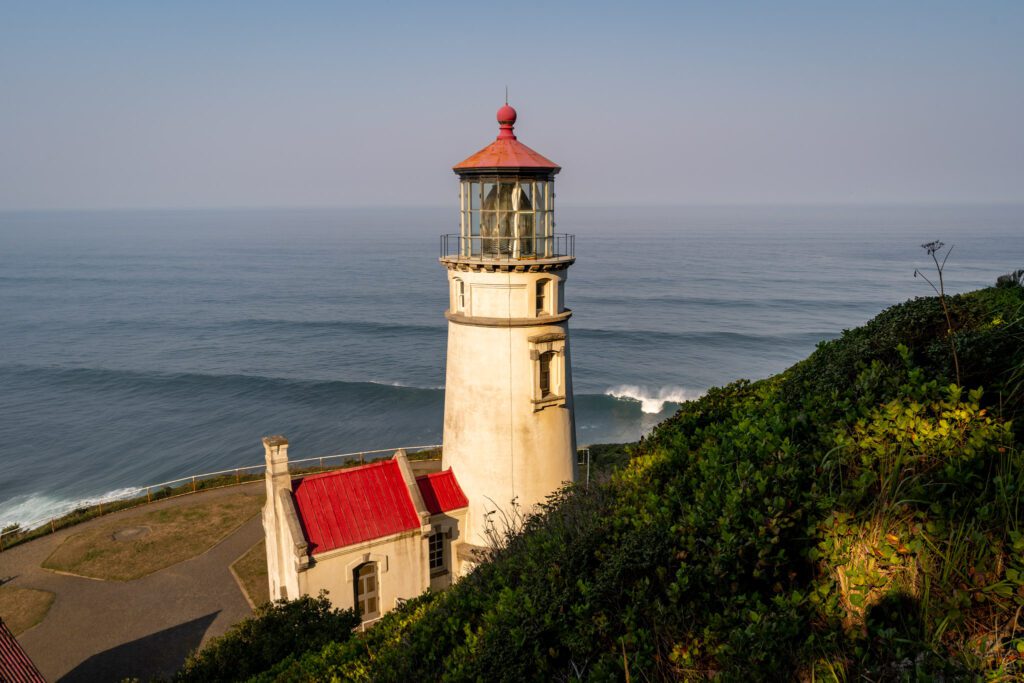
It was built in 1894, and still operates today (though it’s automated). You’ll need to either pay $5 or have an Oregon State Parks Pass to park at the lot, then it’s a nice walk up to the lighthouse’s perch.
Today, there’s even a bed and breakfast at the historic keeper’s quarters! You can also hike from the lighthouse to Hobbit Beach – more information here.
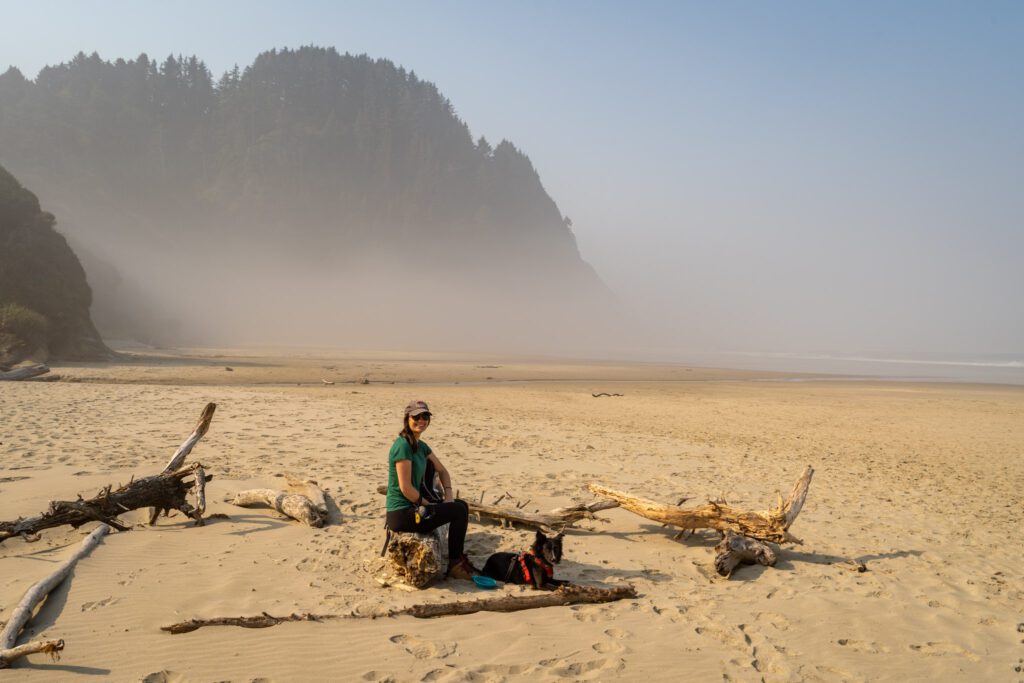
The Sea Lion Caves: Look, we drove past this place on our first trip, saw a line out the door of a tiny little touristy-looking hut, and said “look at those suckers!” Then we learned what it actually was later on, and were at least a little bit disappointed that we didn’t stop in.
If you want to see sea lions, this is the place to do it. That hut sits over an elevator that takes you down hundreds of feet to the water level, where there’s a sea cave – America’s largest, in fact – filled to the brim with barking sea lions.
They’re open 9:00 am – 4:00 pm 363 days a year, and it costs $16 for adults, $10 for kids (under 4 are free!), making it a little bit pricey.
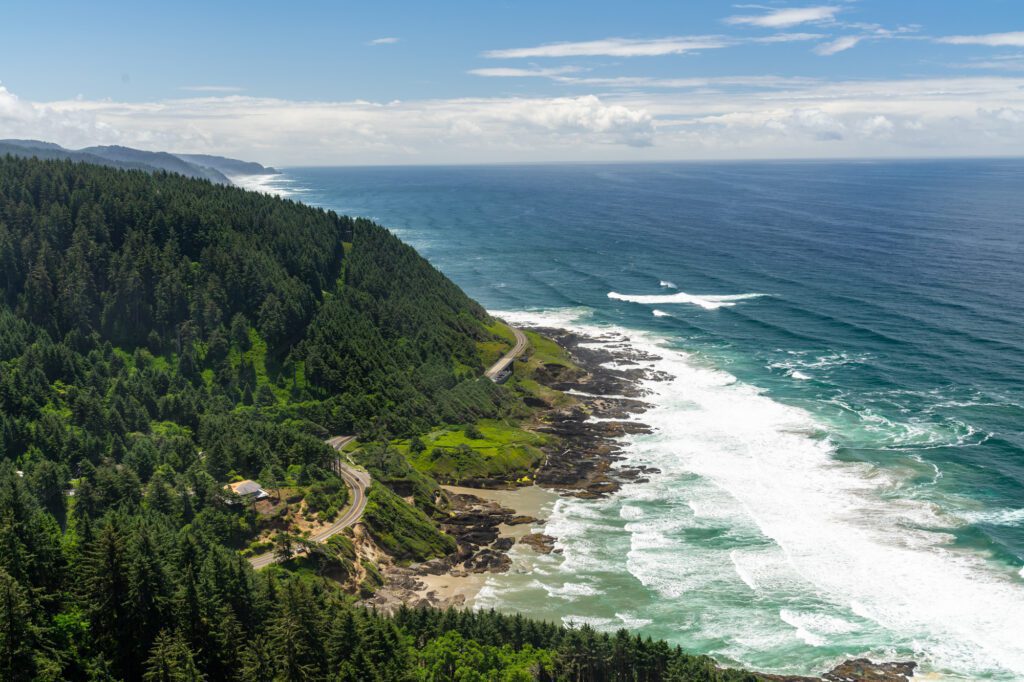
Days 8-9: Bandon, Coos Bay, & Around
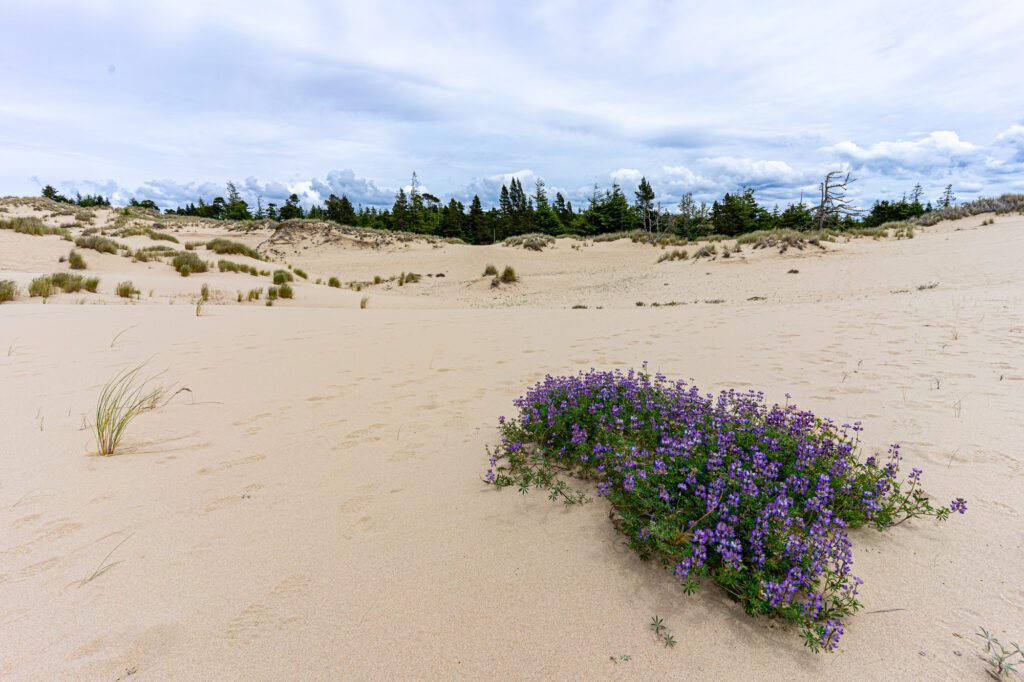
The towns of Coos Bay and Bandon, which are about 30 minutes apart, form a nice stretch of coast ranging from rocky and rugged places like Cape Arago, to wide sandy beaches like the ones near Bandon.
The town of Coos Bay isn’t really worthy of too much of your time – but the stretch of state parks to the west between Sunset Bay State Park and Cape Arago is great – and Bandon is definitely worth a stop.
Bandon is a sleepy little beach town, with a brewery and cidery, and two pretty spectacular beaches that have to be among the best on the entire coast.
However, one thing we do want to make sure you don’t miss is the Oregon Dunes.
Continuing south from the sea lion caves, you’ll pass through the small town of Florence before hitting the most unique stretch of the Oregon Coast, the Oregon Dunes. Stop by River Roasters for some good coffee in town, and then head out to the dunes.
The Oregon Dunes National Recreation Area is a huge stretch of coast covering 31,500 acres along the coast between Florence and North Bend.
Driving along the road is a weird experience, because for large stretches you actually can’t see the dunes.
You might start to notice the sand along the sides of the road, but you’ll essentially have forest on one side, and a string of lakes on the other, with exactly zero dunes in sight.
What you can’t see is on the other side of that forest, there’s a huge swath of land that is basically just a bunch of rolling hills of sand that take you all the way to the ocean.
You should know that OHVs are legal on the dunes, which means you’re very likely to hear the humming of engines revving as you try to enjoy your peace and solitude.
The Oregon Dunes are one place we think you shouldn’t miss – though there are obviously tons and tons of things to do and see here.
We’re not into OHVs, so it’s not really our thing. But if you are, then you can rent one or join a guided tour at Spinreel in North Bend.
What to Do Around Bandon / Coos Bay
Here are a few things to add to your itinerary between Coos Bay and Bandon.
The John Dellenback Dunes Trail
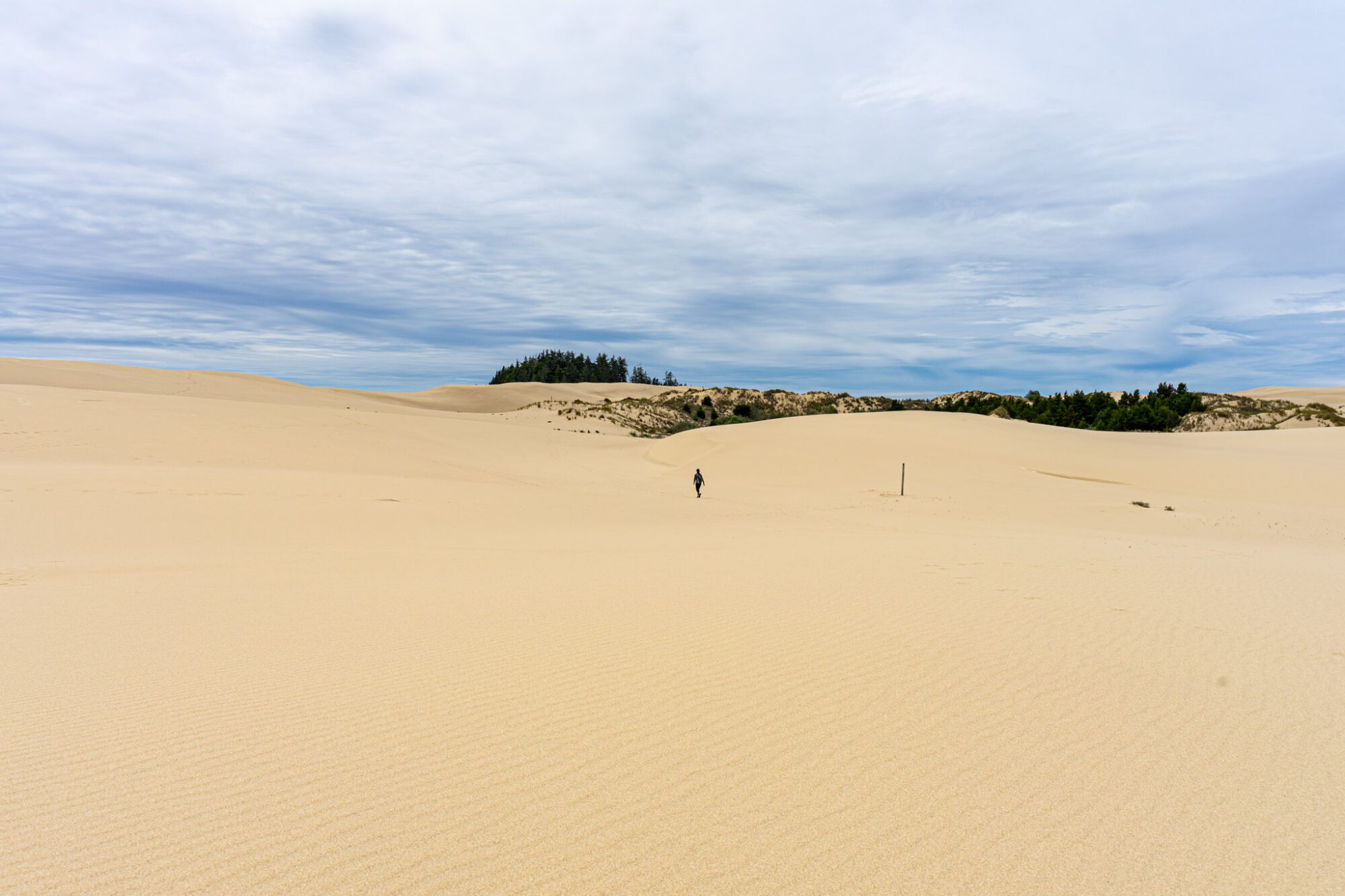
This is the best hike to experience the dunes, we think. You’ll start in the forest, though you’re walking on sand as you make your way to the edge of the trees, where you’ll come face-to-face with the sprawling dunes stretching out for miles.
The coolest part is the islands of trees that somehow exist smack dab in the middle of the dunes.
You’ll snake your way across the dunes – remember, hiking on sand is HARD – before briefly re-entering a different forest and emerging out onto a never ending wide sandy beach, where you’re likely to be one of just a few people out there.
Bring plenty of water and snacks – this hike is probably going to take you longer than you think.
More trail information, including recent trail reports, here.
The Tahkenitch Dunes Trail is a good alternative, but we prefer the John Dellenback version.
Sunset Bay State Park & Shore Acres
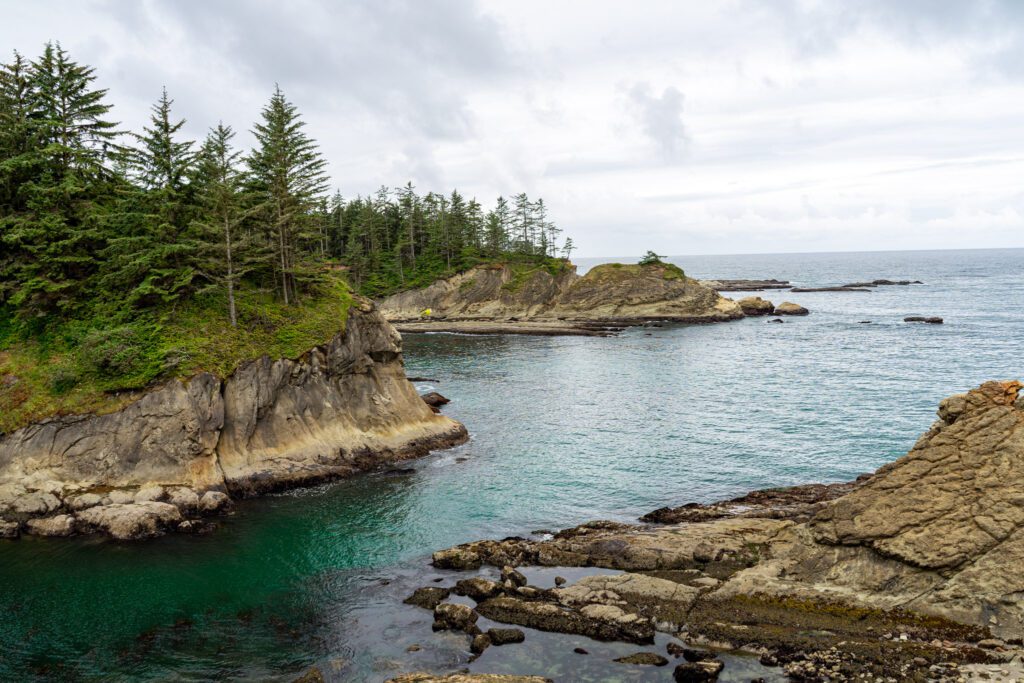
The beach is the highlight here, and it’s a nice protected cove safe from the crashing waves that exist just outside the walls of the cove.
This is also the starting point of an 8.5 mile hike along the coast (part of the Oregon Coast Trail) connecting Sunset Bay with Shore Acres and Cape Arago – more information here.
The highlight at Shore Acres State Park is easily the garden, which includes an impressive rose garden.
Cape Arago State Park
Another cape? How many capes are there on the Oregon Coast? Apparently there are 11 named capes, and probably countless unnamed ones.
Anyway, Cape Arago State Park is the end of the road out here west of Coos Bay, and is a place to see sea lions and other sea life from an overlook that sits above a particular set of rocks that they seem to love.
It’s rugged and rocky, and on stormy days it’s a cool place to go watch the huge waves crashing onto the rocks below.
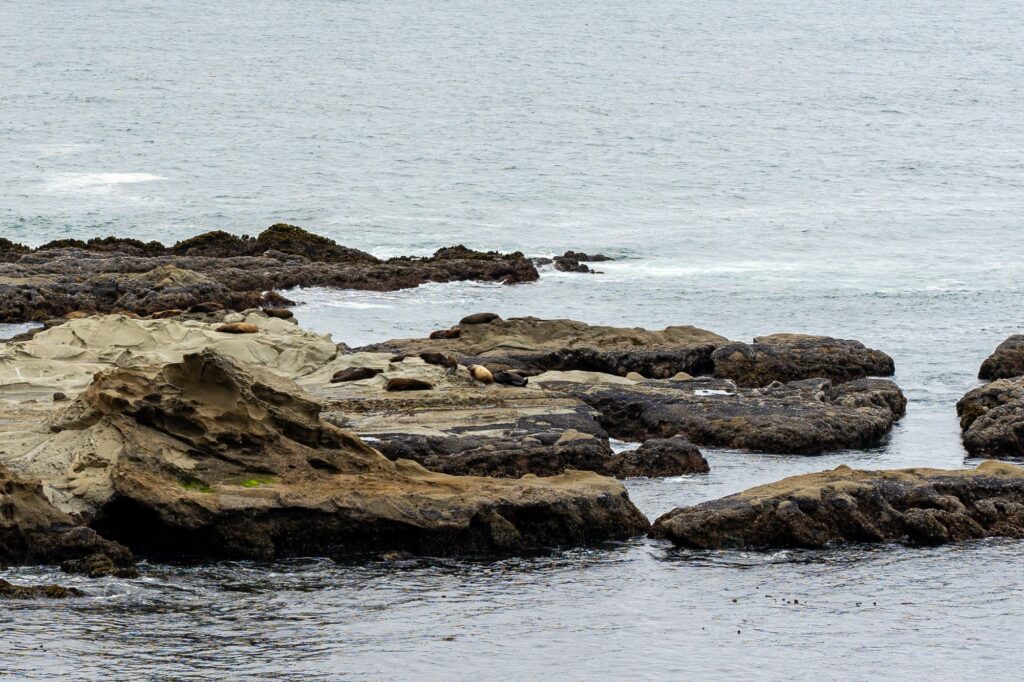
Bandon Beach & Bullards Beach
Bandon’s two main beaches are on either side of the inlet of the Coquille River.
As you come to the beach, you’ll notice the sandy beaches of the northern and central coast are starting to give way to the rocky, rugged beaches with picturesque sea stacks that you’ll find on the southern coast, particularly in the Samuel H. Boardman Scenic Corridor (your next stop).
Because they’re separated by the river, it’s actually not that easy to get from one to the other – it takes 15 minutes to drive between them.
If we have to choose, we choose Bandon. Don’t miss Face Rock Scenic Viewpoint (and Devil’s Kitchen, which is 5-7 minutes south by car).
Day 10: Samuel H. Boardman Scenic Corridor + Brookings
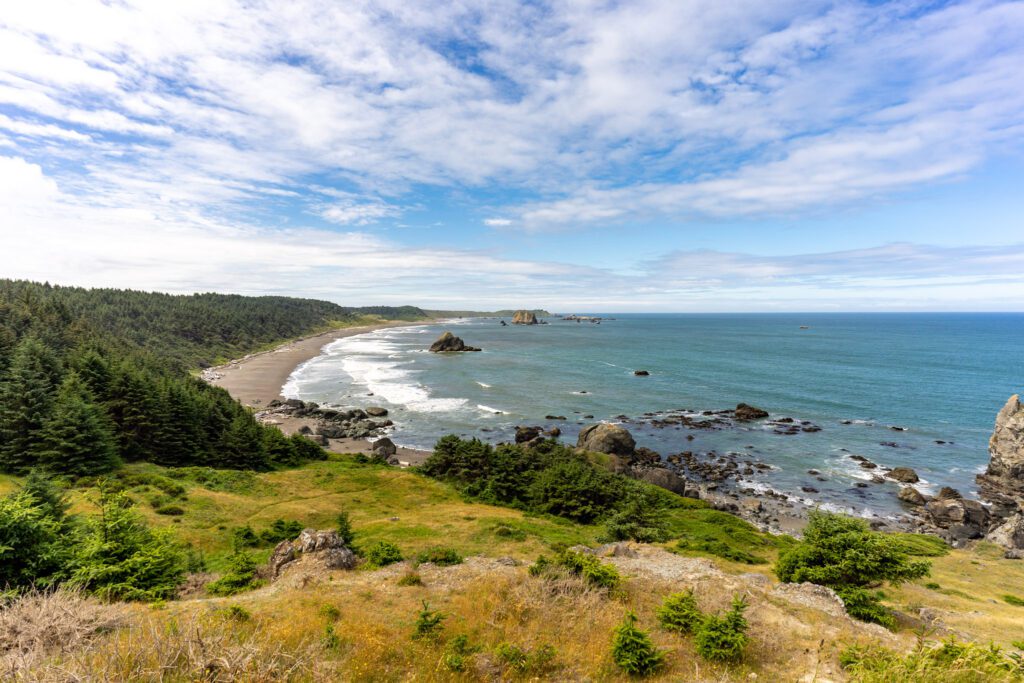
The stretch of coast from Port Orford to Brookings is one of our favorite pieces of the Oregon Coast, partially because it’s significantly less crowded than the parts of the coast up north due to the fact that it’s really not close to any major cities or airports.
It’s rugged, rocky, full of sitka spruce trees – which are emblematic of the Oregon Coast, at least to us – and is known for being more sunny and warm than the stretch further north (with a nickname of “the banana belt”.
There are also some fantastic sandy beaches and plenty of mossy sitka spruce to keep you company along the way.
In this section, we’ll go through our favorite stops, again organized from north to south.
Most of these are either very, very short hikes, or hikes that are three miles or less.
You can easily get a few of them under your belt without doing too much hiking. Here’s a nice map and brochure with more information.
Here are our favorite things to do between Bandon and Brookings, which we’re largely breaking up into two separate sections: the drive from Port Orford to Gold Beach, and the Samuel H. Boardman Scenic Corridor.
For each, we’re going to give you our favorite stops in the order in which you’ll encounter them on your road trip.
What to Do On the Drive from Port Orford to Gold Beach
For this stretch, we’re going to cover a huge swath of coastline in one section. Here are our favorite stops.
Blacklock Point
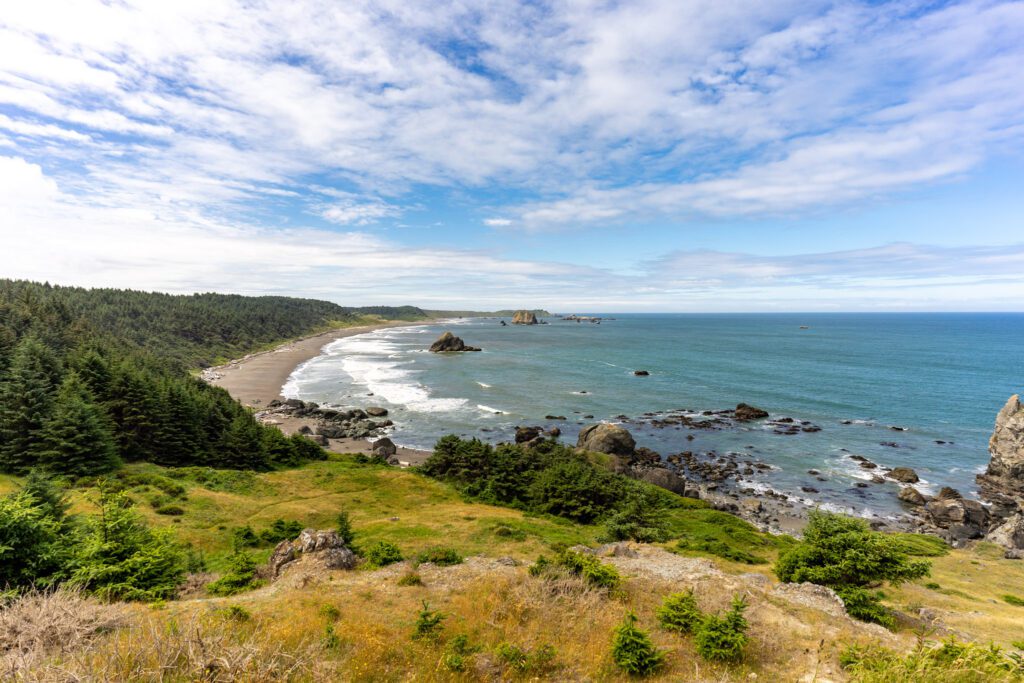
It might feel like you’re not going the right way at the beginning of his hike, as you’re walking along a barbed wire fence next to an airport, but as soon as you get out to Blacklock Point and you find the stunning rocky beach that you have all to yourself, you’ll understand why we included this stop.
You can continue on to Floras Lake, but we think the best part is the beach at Blacklock Point.
More trail information, including recent trail reports, here.
Cape Blanco State Park
Just south of the trailhead for Blacklock Point you’ll find Cape Blanco State Park. This is another of the Oregon Coast’s best lighthouses.
You can drive basically right up to the parking lot, so there’s not a whole lot of hiking or exploring to do here, but it’s worth a stop.
If you want to get out to the beach on the south end of the lighthouse, there’s a short trail that leaves from the parking lot heading south.
Port Orford Heads State Park
Worth a quick stop in Port Orford to walk the short trail with great coastal views.
Humbug Mountain State Park
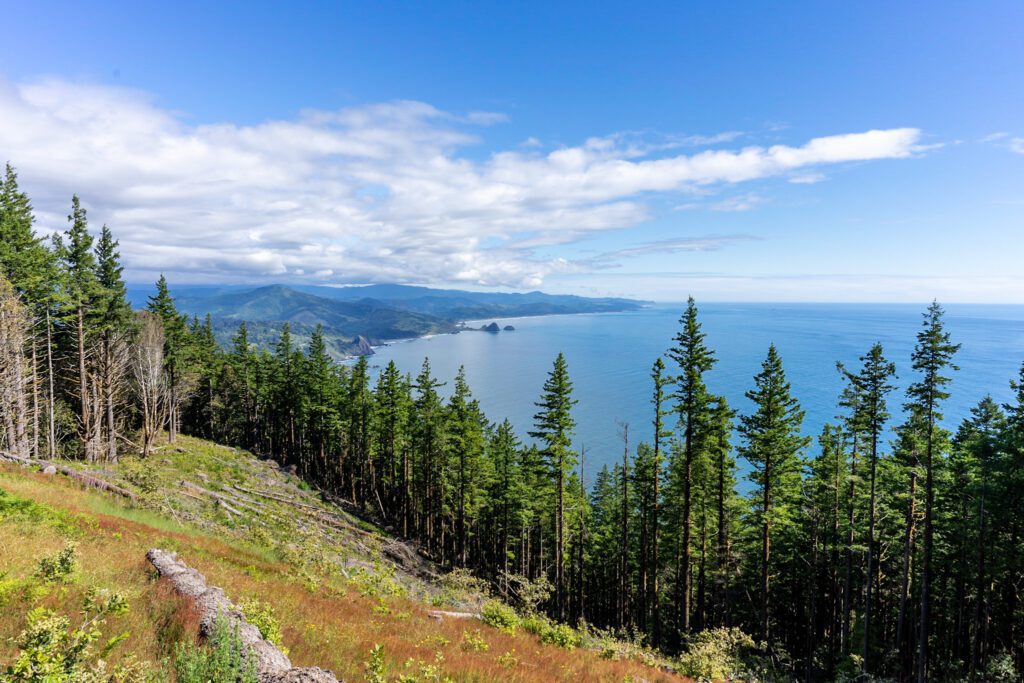
Another amazing Oregon State Park! Two things here.
First is the tough climb up to the summit of Humbug Mountain (trail guide here), which is hard but worth it for the views at the top.
After your hike, head under the highway to the other side to get out to this beach (we can’t find a name for it!), which is accessible from a trail at the western end of the campground. It’s a great beach!
We camped at Humbug Mountain on our first trip up the coast, and spent a beautiful sunset out there.
The Samuel H. Boardman Scenic Corridor
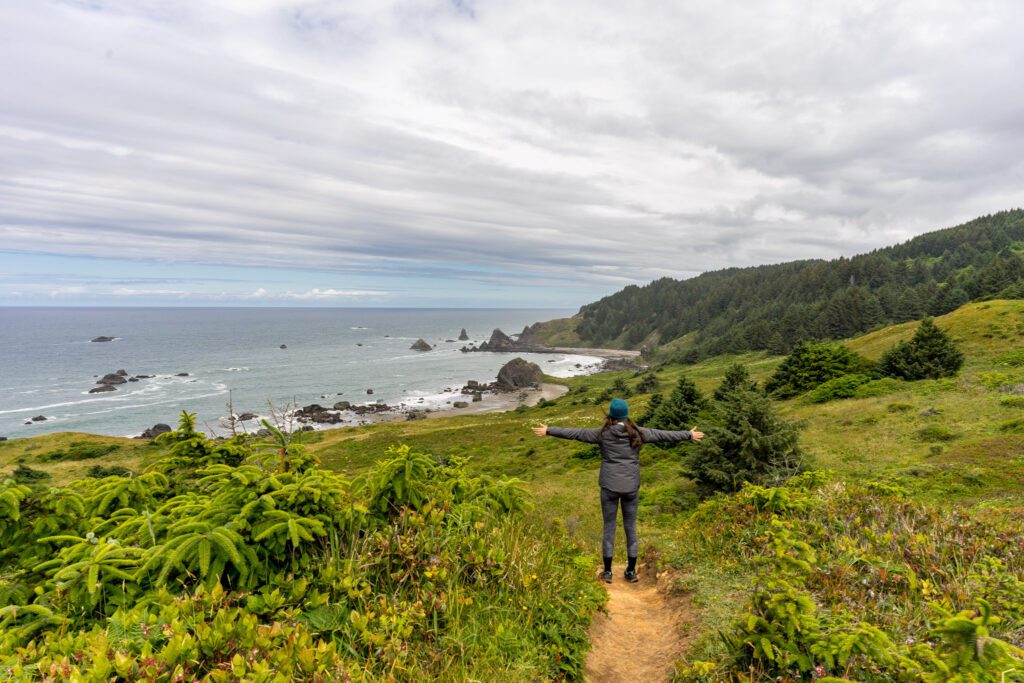
In many ways, this is the main event of the southern Oregon Coast. This is, without a doubt, our favorite stretch on the entire Oregon Coast.
At least when it’s not stormy and quite literally raining sideways with thick coastal fog, which were the conditions on our latest trip in the dead of winter (cool in a different way, I guess).
The Samuel H. Boardman Scenic Corridor runs from the town of Gold Beach at the north end to the town of Brookings, which is essentially on Oregon’s southern border with California.
It’s named after the first superintendent of the Oregon State Parks system – Samuel H. Boardman – who was almost single handedly responsible for acquiring the land for this stretch of protected coast.
His pitch for a national park on the Oregon Coast was shot down by the powers that be, but he got a deal done for this piece under the state parks system.
It’s everything we like about the southern Oregon coast (and the northern California coast, for that matter) encapsulated in one hour-long stretch of driving. Not including stops, and there will be a bunch!
Cape Sebastian
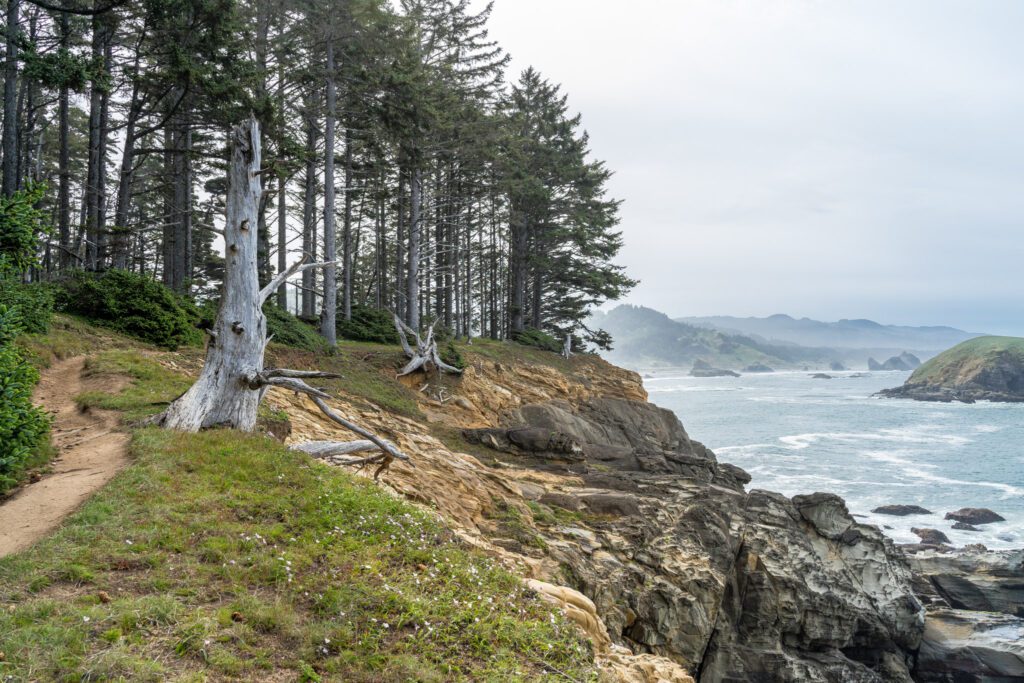
This was the first hike we ever did on the Oregon Coast, and what an introduction it was!
This hike has everything that we love about the Oregon Coast – huge groves of sitka spruce trees, rugged, rocky coastline, and fresh sea air.
It’s an easy 2.7 mile hike, but you hike downhill on the way out, which means an uphill climb on the way back (which includes a not insignificant number of switchbacks).
Secret Beach
The best beach on the Oregon Coast? But it’s not quite those big sandy beaches you find at places like Cannon Beach and Fort Stevens State Park.
Instead, it’s a short little hike off the side of the highway that takes you down to a, well, secret beach that is best explored at low tide (check them here).
Natural Bridges
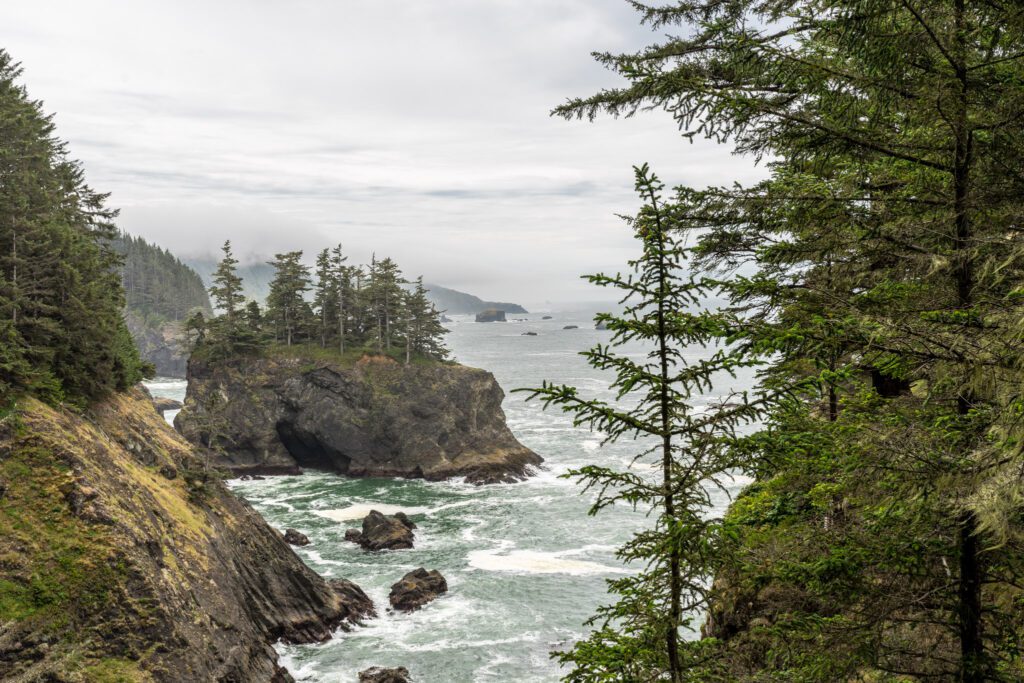
Not very far down the road is another great viewpoint. We’ve seen people hike all the way down to stand out on the natural bridge, which is insane and you definitely shouldn’t do that.
Instead, admire the view from the viewpoint, and if you’re feeling adventurous, take the established trail down and to the right from the parking lot, which takes you down to a great view of the rock formations.
It’s a little slick after rain, so make sure you have proper footwear.
Indian Sands
A short and sweet loop that includes some climbing on sand, cool coastal views, and should only take about half an hour or so.
Whaleshead Beach
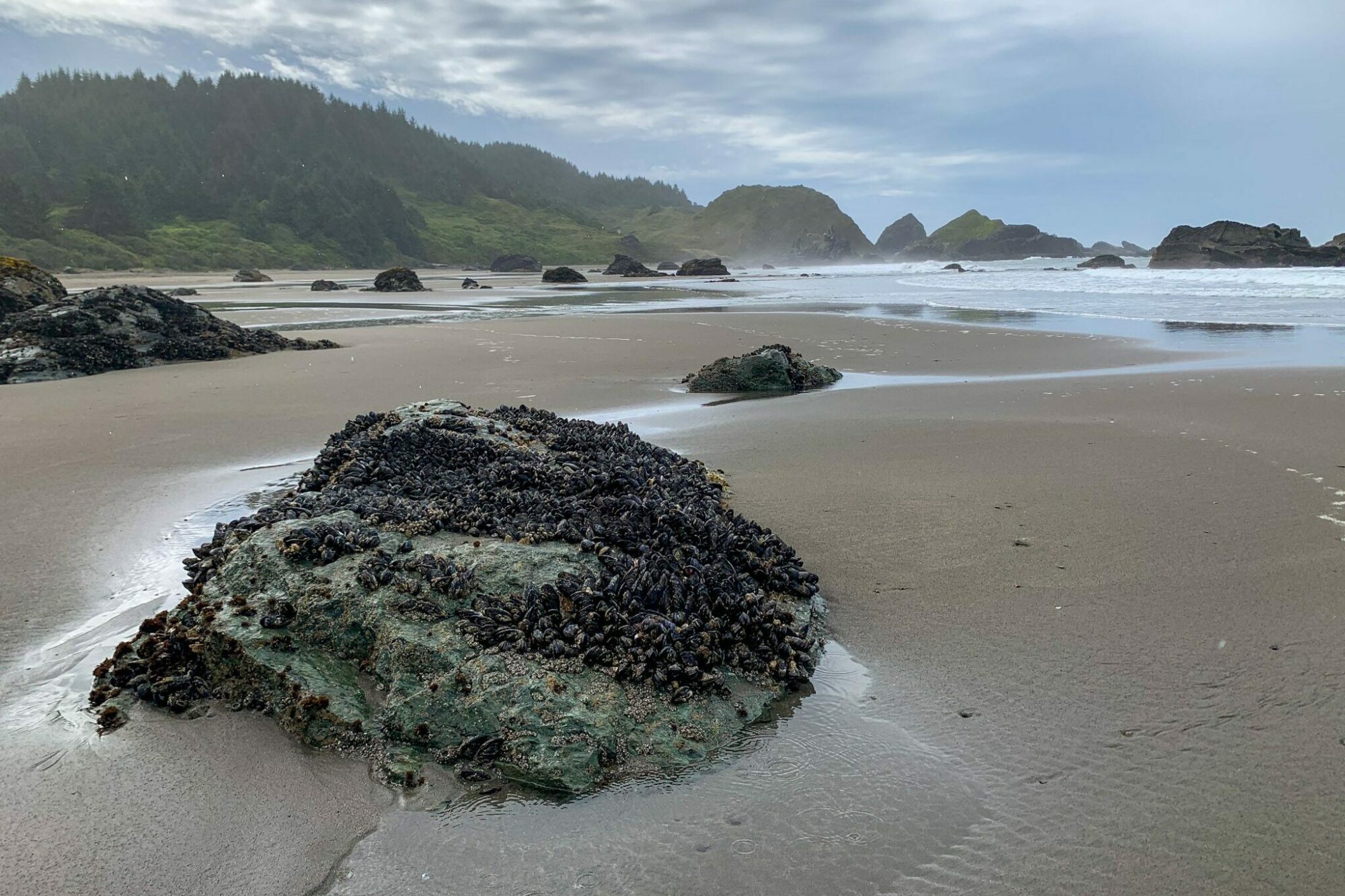
Just south of the Indian Sands trailhead, this beach has a rough road leading to it, so if you’re concerned about clearance, you can walk down in 10-15 minutes.
At low tide, there are some cool tidepools that form in the rocks with all sorts of sea life.
Cape Ferrelo
The end of this hike, which takes you out to the tip of Cape Ferrelo, is pretty cool. It’s short, and well worth the stop for, you guessed it, more amazing coastal views out over Lone Ranch Beach.
You can also hike up to the head from the beach, which is actually what we did.
Park here and walk up the trail on the hill to the right (or to the north).
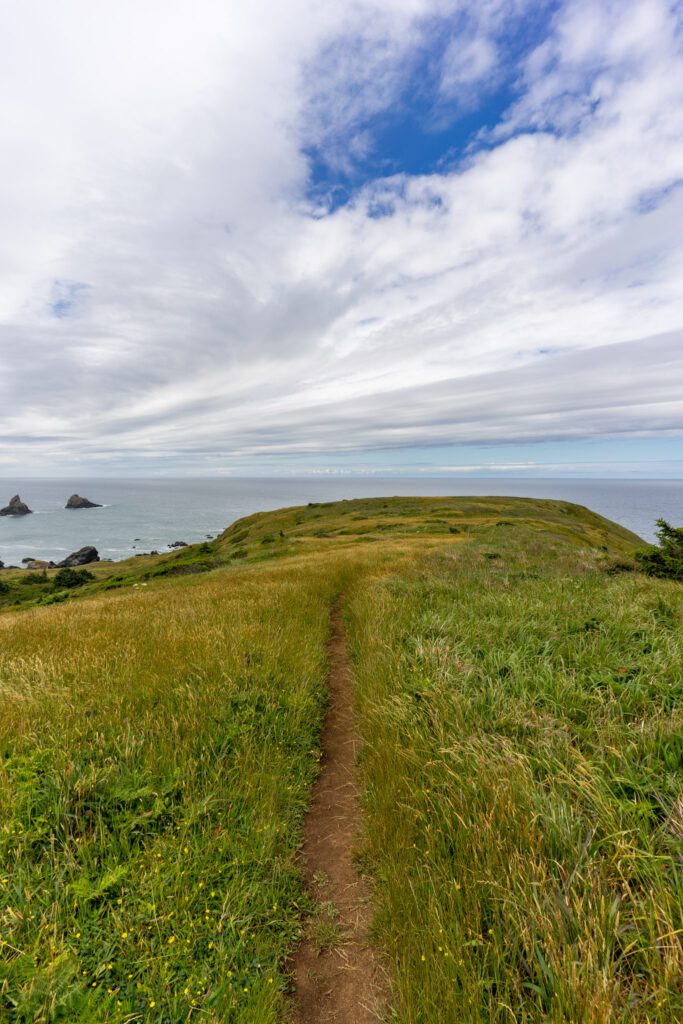

What to Do with More Time on the Oregon Coast
If you have more time on the coast, our basic recommendation is to EITHER spend more days in the places already on this itinerary OR extend your road trip by adding some stops.
We’d make those stops either in northern California (the north coast redwoods are magnificent!) or along the I-5 corridor (places like Ashland, the Willamette Valley, and Silver Falls State Park).
If you want to add more time along the coast, your best bet would be one or two extra days in Astoria, Cannon Beach, Bandon/Coos Bay, and maybe a stop somewhere else on the southern Oregon Coast (like Port Orford) to break up that stretch of driving.
What to Do with Less Time on the Oregon Coast
As you might be able to tell from this guide, there is A LOT to see on the Oregon Coast.
And once you get south of Newport, things get further and further apart, which means a lot of driving if you’re pressed for time.
If you have seven days or less, we strongly recommend that you focus on the northern half of the coast – the stretch from Astoria to Newport (with a drive through Cape Perpetua and back) to make the most of your time.
This will also put you in a better position to get back to Portland (or wherever you’re flying home from).
7 Days on the Oregon Coast
Here’s what a seven day trip might look like on that stretch. Spoiler alert: it’s literally the first seven days of the main itinerary.
- Day 1: Astoria
- Day 2: Cannon Beach & Around
- Day 3: Cannon Beach & Around
- Day 4: Tillamook & Three Scenic Capes
- Day 5: Tillamook & Three Scenic Capes
- Day 6: Newport & Around
- Day 7: Newport & Around
5 Days on the Oregon Coast
With 5 Days, we think you should focus on the stretch between Astoria and Tillamook, which has the most bang-for-your-buck in terms of the ratio of driving to sights.
You could also do Tillamook and Newport in that timeframe, it depends on what appeals to you.
Here’s what a nice five day itinerary would look like (you could even stay in Cannon Beach for all five days and do day trips to the other places, if you wanted).
- Day 1: Astoria
- Day 2: Cannon Beach & Around
- Day 3: Cannon Beach & Around
- Day 4: Tillamook & Three Scenic Capes
- Day 5: Tillamook & Three Scenic Capes
